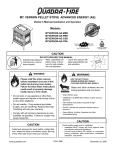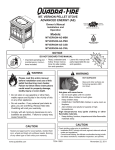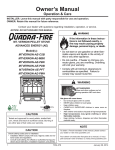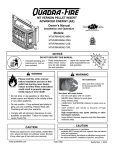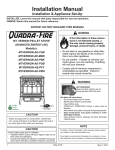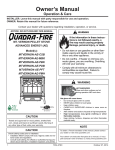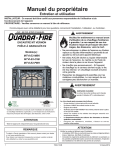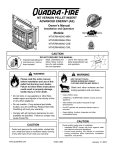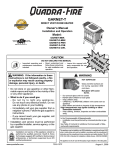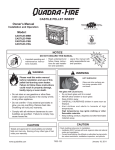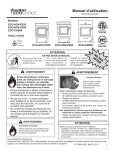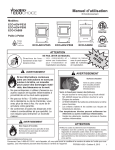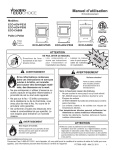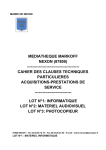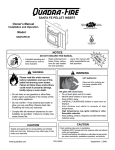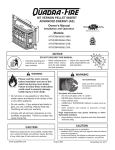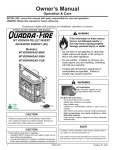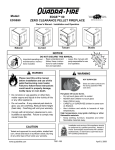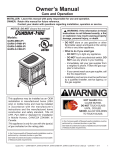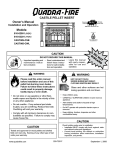Download Quadra-Fire MTVERNON-AE
Transcript
R MT. VERNON PELLET STOVE ADVANCED ENERGY (AE) Owner’s Manual Installation and Operation Tested and Listed by Portland Oregon USA O-T L C US OMNI-Test Laboratories, Inc. Models: MTVERNON-AE-MBK MTVERNON-AE-PMH MTVERNON-AE-CSB MTVERNON-AE-CWL NOTICE • Important operating and • Read, understand and • Leave this manual with follow these instrucparty responsible for use maintenance instructions for safe installaand operation. tions included. tion and operation. WARNING Please read this entire manual before installation and use of this pellet fuel-burning room heater. Failure to follow these instructions could result in property damage, bodily injury or even death. • Do not store or use gasoline or other flammable vapors and liquids in the vicinity of this or any other appliance. • Do not overfire - If any external part starts to glow, you are overfiring. Reduce feed rate. Overfiring will void your warranty. • Comply with all minimum clearances to combustibles as specified. Failure to comply may cause house fire. CAUTION Tested and approved for wood pellets, shelled field corn, wheat and black oil sunflower seeds. Burning of any other type of fuel voids your warranty. www.quadrafire.com T O N RD O A D SC I D DO NOT DISCARD THIS MANUAL WARNING HOT SURFACES! Glass and other surfaces are hot during operation AND cool down. Hot glass will cause burns. • Do not touch glass until it is cooled • NEVER allow children to touch glass • Keep children away • CAREFULLY SUPERVISE children in same room as fireplace. • Alert children and adults to hazards of high temperatures. High temperatures may ignite clothing or other flammable materials. • Keep clothing, furniture, draperies and other flammable materials away. CAUTION Check building codes prior to installation. • Installation MUST comply with local, regional, state and national codes and regulations. • Consult local building, fire officials or authorities having jurisdiction about restrictions, installation inspection, and permits. 7034-106E September 1, 2008 R Mt. Vernon Pellet Stove (AE) Hearth & Home Technologies welcomes you to our tradition of excellence! In choosing a Quadra-Fire appliance, you have our assurance of commitment to quality, durability, and performance. This commitment begins with our research of the market, including ‘Voice of the Customer’ contacts, ensuring we make products that will satisfy your needs. Our Research and Development facility then employs the world’s most advanced technology to achieve the optimum operation of our stoves, inserts and fireplaces. And yet we are old-fashioned when it comes to craftsmanship. Each unit is meticulously fabricated and surfaces are hand-finished for lasting beauty and enjoyment. Our pledge to quality is completed as each model undergoes a quality control inspection. We wish you and your family many years of enjoyment in the warmth and comfort of your hearth appliance. Thank you for choosing Quadra-Fire. LOCATION OF SAMPLE SERIAL NUMBER / SAFETY LABEL: Back of Stove Serial No. Model Name MINIMUM CLEARANCES TO COMBUSTIBLE MATERIALS B 2 in (51mm) 6 in. (152mm) 2 in. (51mm) 3 in. (76mm) E 6 in. (152mm) F 8 in. (203mm) G 3 in. (76mm) P INSTALLATION DE L’ALCÔVE Une hauteur minimum de l'alcôve: Une hauteur minimum mur de côté de l'alcôve: Une épaisseur minimum mur de côté de l'alcôve: La profondeur maximum de l'alcôve: C C F Note 1: Dans les installations résidentielles, lorsque les pièces TPVNT-MV, (dessus de l'adapteur de ventilation 3 in. - 3 in.) et 812-3570 (le ressaut de l'adapteur 3 in. - 6 in.), un tuyau connecteur de 6 in. pour mur simple de calibre 24 peut être utilisé. A Note 2: Pour l'installation dans les maisons préfabriquées, lorsque les pièces TPVNT-MV, (dessus de l'adapteur de ventilation 3 in. - 3 in.) et 812-3570 (le ressaut de l'adapteur 3 in. - 6 in.), utilisez un tuyau connecteur enregistré pour mur double. Un assemblage d'air extérieur (pièce 811-0872), doit être utilisé pour l'installation dans les maisons préfabriquées. D S E G M 43 in.(1092mm) 6 in. (152mm) 40 in. (1016mm) 36 in. (914mm) G PROTECTION DU SOL I* = 2 in. (51mm) J = 2 in. (51mm) K = 6 in. (152mm) Manufactured by / Fabriqué par: 1445 Highway North, Colville, WA 99114 I* www.quadrafire.com Made in the USA J J K Fait-Aux États-Unix DO NOT REMOVE THIS LABEL NE PAS ENLEVER L’ÉQUETTE 7034-106E C F Note 1: In residential installations, when using Parts TPVNT-MV, (3 in. - 3 in. Top Vent Adapter) and 812-3570 (3 in. - 6 in. Offset Adapter), 24 gauge 6 in. single wall flue connector may be used. D E G G Note 2: In manufactured home installation, when using Part TPVNT-MV, (3 in. - 3 in. Top Vent Adapter) and 812-3570 (3 in. - 6 in. Offset Adapter), use listed double wall flue connector. An Outside Air Kit (Part 811-0872), must be used with manufactured home installation. FLOOR PROTECTION I* I* = 2 in. (51mm) J J J = 2 in. (51mm) K = 6 in. (152mm) K Use a non-combustible floor protector, extending beneath heater and to the front/sides/rear as indicated. Measure front distance (K) from the surface of the glass door. *Non-combustible floor protection must extend beneath the flue pipe when installed with horizontal venting or under the Top Vent Adapter with vertical installation. RECOMMENDED IN USA Mfg Date Page 2 C 2 in (51mm) 6 in. (152mm) 2 in. (51mm) 3 In (76mm) 6 in (152mm) 8 in.(203mm) 3 in. (76mm) JULY AUG SEPT OCT NOV DEC A B C D A E L ESPACES LIBRES MINIMUM DES MATÉRIAUX COMBUSTIBLES: SERIAL NO. / NUMÉRO DU 007001 Tested & Listed by 2009 TOUCHER. GARDEZ LES ENFANTS ET LES VÊTEMENTS LOIN DE L'ESPACE DÉSIGNÉ DE L'INSTALLATION. LE CONTACT PEUT CAUSER DES BRÛLURES À LA PEAU. VOIR A B C D E F G B 2008 ATTENTION:CHAUD LORS DE L'OPÉRATION. NE PAS Tested to: ASTM E1509-04, ULC S627-00, ULC/ORD-C1482-M1990 Room Heating Pellet Burning Type, (UM) 84-HUD FOR USE ONLY WITH PELLETIZED WOOD. See Owner’s Manual for other fuel options. Input Rating: 60,000 Btu's/hr. Electrical Rating: 115 VAC, 60 Hz, Start 5 Amps, Run 1.25 AMPS. Route power cord away from unit. Do not route cord under or in front of appliance. DANGER: Risk of electrical shock. Disconnect power supply before servicing. Replace glass only with 5mm ceramic available from your dealer. To start, set thermostat above room temperature, the stove will light automatically. To shutdown, set thermostat to below room temperature. For further instruction refer to owner's manual.Keep viewing and ash removal doors tightly closed during operation. Mt. Vernon Pellet Stove AE A 43 in. (1092mm) Min. Alcove Side Wall: 6 in. (152mm) Min. Alcove Width: 40 in. (1016mm) Max. Alcove Depth: 36 in. (914mm) JAN FEB MAR APR MAY JUN KEEP CHILDREN, CLOTHING AND FURNITURE AWAY. ALCOVE INSTALLATION: Min. Alcove Height: 2007 CAUTION :HOT WHILE IN OPERATION DO NOT TOUCH, Listed Solid Fuel Room Heater/Pellet Type Stove. Also suitable for Mobile Home Installation. This appliance has been tested and listed for use in Manufactured Homes in accordance with OAR 814-23-9000 through 814-23-909. O-T L C Beaverton Oregon USA US OMNI-Test Laboratories, Inc. Report / Rapport 061-S-68-6 7034-107B Test Lab & Report No. September 1, 2008 R Mt. Vernon Pellet Stove (AE) TABLE OF CONTENTS Section 1: Listing and Code Approvals A. B. C. D. E. Section 8: Operating Instructions Appliance Certifications ......................4 Mobile Home Approved ......................4 Glass Specifications ............................4 Electrical Rating ..................................4 BTU & Efficiency Specifications ..........4 A. B. C. D. E. Fuel Size, Material & Storage .............22 General Operation Information ...........23 Before Your First Fire .........................23 Starting Your First Fire........................23 Fire Characteristics & Flame Height Adjustment ..........................................24 F. Battery Back-Up System.....................24 G. Ignition Cycles ....................................24-25 H. Quick Start Guide ...............................26-27 I. Frequently Asked Questions...............28 Section 2: Getting Started A. Design, Installation & Location Considerations ....................................5 B. Locating Your Appliance & Chimney ..6 C. Wall Control, Thermostat ....................6 D. Draft ....................................................6 E. Negative Pressure ..............................6 F. Fire Safety ..........................................7 G Tools & Supplies Needed ...................7 H. Inspect Appliance & Components and Pre-Use Checklist .......................7 Section 9: Troubleshooting ............................29 Section 10: Maintaining & Servicing Appliance A. B. C. D. E. F. G. H. Section 3: Dimensions & Clearances A. Appliance Dimensions ........................8 B. Clearances to Combustibles ...............9 C. Hearth Pad Requirements ..................9 Section 4: Vent Information A. Venting Termination Minimum Requirements ......................................10 B. Chimney & Exhaust Connection .........11 C. Equivalent Feet of Pipe .......................11 D. Pipe Selection Chart ............................12 Section 11: Reference Materials A. B. C. D. E. F. G. H. Section 5: Venting Systems A. B. C. D. E. F. G. Proper Shutdown Procedures .............30 Quick Reference Maintenance Chart ..30 General Maintenance & Cleaning .......31-35 High Ash Fuel Content Maintenance ..35 Baffle Removal ....................................35 Convection Blower Replacement ........36 Combustion Blower Replacement .......37 Glass Replacement .............................37 Alcove .................................................13 Through the Wall .................................14 Vertical into Class A Chimney .............15 Through the Wall & Vertical-Exterior ...15 Vertical-Interior ....................................15 Masonry ..............................................16 Alternate Masonry ...............................16 Component Functions.........................38-39 Component Locations .........................40 Exploded Drawings .............................41-42 Service Parts & Accessories ...............43-46 Service & Maintenance Log ................47-48 Homeowner’s Log ...............................49 Warranty Policy ...................................50-51 Contact Information .............................52 Section 6: Mobile Home Installation ............17 Section 7: Appliance Set-Up A. B. C. D. E. F. Leg Leveling System ..........................18 Outside Air Kit .....................................18 Top Vent Adapter ................................19 Rear Vent Adapter ..............................19 Log Set Placement ..............................20 Wall Control Thermostat .....................21 September 1, 2008 7034-106E Page 3 R Mt. Vernon Pellet Stove (AE) 1 Listing and Code Approvals E. BTU & Efficiency Specifications A. Appliance Certification Model Mt. Vernon Pellet Stove AE Laboratory OMNI Test Laboratories, Inc. Report No. 061-S-68-6 Type Solid Fuel Room Heater/Pellet Type Standard ASTM E1509-04, ULC S627-00 and ULC/ORD-C1482-M1990 Room Heater Pellet Fuel Burning type and (UM) 84HUD, Mobile Home Approved. FCC Emissions Rating: EPA Compliance Complies with Part 15 of FCC Rules. Operation is subject to the following two conditions: (1) this device may not cause harmful interference, and (2) this device must accept any interference received, including interference that may cause undesired operation. B. Mobile Home Approved This appliance is approved for mobile home installations when not installed in a sleeping room and when an outside combustion air inlet is provided. The structural integrity of the mobile home floor, ceiling, and walls must be maintained. The appliance must be properly grounded to the frame of the mobile home and use only listed pellet vent Class “L” or “PL” connector pipe. A Quadra-Fire Outside Air Kit must be installed in a mobile home installation. *BTU Output: 14,620 - 60,200 Efficiency: 81.4% - 83.6% Heating Capacity: 2,400 - 3,800 square feet depending on heating zone Hopper Capacity: 81 lbs Fuels: Pellets, Shelled Field Corn, Wheat and Black Sunflower Seeds Shipping Weight: 429 lbs *BTU output will vary, depending on the type of fuel you use in your stove. Consult your Quadra-Fire dealer for best results. NOTE: Hearth & Home Technologies, manufacturer of this appliance, reserves the right to alter its products, their specifications and/or price without notice. C. Glass Specifications This appliance is equipped with 5mm ceramic glass. Replace glass only with 5mm ceramic glass. Please contact your dealer for replacement glass. NOTE: This installation must conform with local codes. In the absence of local codes you must comply with the ASTM E1509, ULC S627-00, (UM) 84-HUD and ULC/ ORD-C-1482. D. Electrical Rating 115 VAC, 60 Hz, Start 5 Amps, Run 1.25 Amps Page 4 7034-106E September 1, 2008 R 2 Mt. Vernon Pellet Stove (AE) Getting Started A. Design, Installation & Location Considerations Since pellet exhaust can contain ash, soot or sparks, you must consider the location of: 1. Appliance Location • Windows OT Check building codes prior to installation. • Installation MUST comply with local, regional, state and national codes and regulations. • Air Intakes • • Landscaping, vegetation Consult insurance carrier, local building inspector, fire officials or authorities having jurisdiction over restrictions, installation inspection and permits. It is a good idea to plan your installation on paper, using exact measurements for clearances and floor protection, before actually beginning the installation Consideration must be given to: • Safety, convenience, traffic flow • Placement of the chimney and chimney connector. • If you are not using an existing chimney, place the appliance where there will be a clear passage for a factorybuilt listed chimney through the ceiling and roof. • Installing an optional outside air kit would affect the location of the vent termination. Recommended Location A ove pea • Air Conditioner • Overhang, soffits, porch roofs, adjacent walls When locating vent and venting termination, vent above roof line when possible. Damaged parts could impair safe operation. Do NOT install damaged, incomplete or substitute components. TO If burning shelled field corn, you must use approved venting specifically designed for corn to prevent corrosion or degradation. Follow the instructions from the venting manufacturer. OT Locating the appliance in a location of considerable air movement can cause intermittent smoke spillage from appliance. Do not locate appliance near: • Frequently open doors • Central heat outlets or returns Recommended Location A ove pea Inside heated space Marginal Location Wind loading possi le Marginal Location Below pea Location NOT recommended Not the highest point of the roof Wind loading possi le Recommended Insulated exterior chase in cooler climates Location NOT recommended Too close to tree Below ad acent structure Lower roof line Avoid outside wall Windward Leeward Recommended Outside Air Inta e on windward side Multi-level Roofs NOT recommended Outside Air Inta e on leeward side Figure 5.1 September 1, 2008 7034-106E Page 5 R Mt. Vernon Pellet Stove (AE) B. Locating Your Appliance & Chimney E. Negative Pressure Location of the appliance and chimney will affect performance. • Install through the warm airspace enclosed by the building envelope. This helps to produce more draft, especially during lighting and die-down of the fire. • Penetrate the highest part of the roof. This minimizes the effects of wind loading. Negative pressure can cause spillage of combustion fumes and soot. Negative pressure results from the imbalance of air available for the appliance to operate properly. It can be strongest in lower levels of the house. Causes include: Locate termination cap away from trees, adjacent structures, uneven roof lines and other obstructions. • Exhaust fans (kitchen, bath, etc.) • Range hoods • Minimize the use of chimney offsets. • • Consider the appliance location relative to floor and ceiling and attic joists. Combustion air requirements for furnaces, water heaters and other combustion appliances • Clothes dryers • Location of return-air vents to furnace or air conditioning • Imbalances of the HVAC air handling system • Upper level air leaks such as: • • Take into consideration the termination requirements on Page 10. CAUTION - Recessed lighting • Do NOT connect this unit to a chimney flue servicing another appliance. • Do NOT connect to any air distribution duct or system. - Attic hatch - Duct leaks To minimize the effects of negative air pressure: C. Wall Control Thermostat • The wall control’s location will have some affect on the appliance’s operation. Install the outside air kit with the intake facing prevailing winds during the heating season • • When located close to the appliance, it may require a slightly higher temperature setting to keep the rest of the house comfortable. Ensure adequate outdoor air for all combustion appliances and exhaust equipment • Ensure furnace and air conditioning return vents are not located in the immediate vicinity of the appliance • Avoid installing the appliance near doors, walkways or small isolated spaces • Recessed lighting should be a “sealed can” design • Attic hatches weather stripped or sealed • Attic mounted duct work and air handler joints and seams taped or sealed • When located in an adjacent room or on a different floor level, you will notice higher temperatures near the appliance. TO T D. Draft Draft is the pressure difference needed to vent appliances successfully. When an appliance is drafting successfully, all combustion byproducts are exiting the home through the chimney. Considerations for successful draft include: • • Preventing negative pressure Location of appliance and chimney OT Hearth & Home Technologies assumes no responsibility for the improper performance of the chimney system caused by: • Inadequate draft due to environmental conditions • Downdrafts • Tight sealing construction of the structure • Mechanical exhausting devices Page 6 7034-106E September 1, 2008 R Mt. Vernon Pellet Stove (AE) F. Fire Safety G. Tools And Supplies Needed To provide reasonable fire safety, the following should be given serious consideration: • Install at least one smoke detector on each floor of your home. • Locate smoke detector away from the heating appliance and close to the sleeping areas. • Follow the smoke detector manufacturer’s placement and installation instructions and maintain regularly. • Conveniently locate a Class A fire extinguisher to contend with small fires. • In the event of a hopper fire: • Evacute the house immediately. • Notify fire department. Tools and building supplies normally required for installation, unless installing into an existing masonry fireplace: Reciprocating Saw Safety Glasses Channel Locks Framing Square Hammer Electric Drill & Bits (1/4”) Phillips Screwdriver 1/4” Self-Tapping Screws Tape Measure Plumb Line May also need: Level Vent Support Straps Framing Material Venting Paint Hi-temp Caulking Material Gloves H. Inspect Appliance & Components and Pre-Use Check List WARNING 1. Place the appliance in a location near the final installation area and follow the procedures below: 2. Open the appliance and remove all the parts and articles packed inside the Component Pack. Fire Risk. • Do not operate appliance before reading and understanding operating instructions. • Failure to operate appliance properly may cause a house fire. Inspect all the parts and glass for shipping damage. Contact your dealer if any irregularities are noticed. Remove rubber band from ash pan installed for shipping purposes only. WARNING Hearth & Home Technologies disclaims any responsibility for, and the warranty will be voided by, the following actions: • Installation and use of any damaged appliance. • Modification of the appliance. • Installation other than as instructed by Hearth & Home Technologies. • Installation and/or use of any component part not approved by Hearth & Home Technologies. • Operating appliance without fully assembling all components. • Operating appliance without legs attached (if supplied with unit). • Do NOT Overfire Or any such action that may cause a fire hazard. September 1, 2008 3. All safety warnings have been read and followed. 4. This Owner’s Manual has been read. 5. Floor protection requirements have been met. 6. Venting is properly installed. 7. The proper clearances from the appliance and chimney to combustible materials have been met. 8. The masonry chimney is inspected by a professional and is clean, or the factory built metal chimney is installed according to the manufacturer’s instructions and clearances. 9. The chimney meets the required minimum height. 10. All labels have been removed from the glass door. 11. Plated surfaces have been wiped clean, if applicable. 12. Wall Control Thermostat has been installed. 13. A power outlet is available nearby. 14. A good quality surge protectory is highly recommended to protect the electronics. 7034-106E Page 7 R Mt. Vernon Pellet Stove (AE) 3 Dimensions and Clearances A. Appliance Dimensions 14-1/16 in. (357mm) 5-13/16 in. (147mm) 2-9/16 in. (65mm) 3-13/16 in. (97mm) CL 31-1/6 in. (788mm) 29-3/6 in. (741mm) Figure 8.1 - Top View with Top Vent Adapter and 3 to 6 in (76-152mm) Adapter Figure 8.2 - Side View with Top Vent Adapter and 3 to 6 in (76-152mm) Offset Adapter. 10-3/8 in. (264mm) CL Figure 8.3 - Top View 29-1/16 in. (738mm) 28-1/8 in. (714mm) 26-7/8 in. (683mm) 18-1/2 in. (470mm) 32-5/16 in. (821mm) CL 19-9/16 in. (497mm) 28-7/16 in. (722mm) Figure 8.4 - Front View Page 8 20 in. (508mm) Figure 8.5 - Side View 7034-106E September 1, 2008 R Mt. Vernon Pellet Stove (AE) B. Clearances to Combustibles (UL and ULC) Use a non-combustible floor protector, extending beneath appliance and to the front, sides and rear as indicated. Measure front distance “M” from the surface of the glass door. C A C. Hearth Pad Requirements (UL and ULC) L* B C K Straight Back Against Wall Inches A Back Wall to Appliance 2 51 B Side Wall to Appliance 6 152 Inches Millimeters 2 51 Corner Installation C Walls to Appliance M Installations with: 3 to 3 inch Top Vent Adapter and 3 to 6 inch Offset Adapter Kit F G Inches Millimeters D Back Wall to Flue Pipe 3 76 E Side Wall to Appliance 6 152 F Back Wall to Appliance 8 203 Inches Millimeters 3 76 Inches Millimeters Minimum Alcove Height 43 1092 Minimum Alcove Side Wall 6 152 Minimum Alcove Width 40 1016 Maximum Alcove Depth 36 914 Corner Installation G Side Wall to Flue Pipe Alcove Installation Inches Millimeters K Sides 2 51 L* Back 2 51 M Front 6 152 USA INSTALLATIONS: A non-combustible floor protection is recommended extending beneath the flue pipe when installed with horizontal venting or under the Top Vent Adapter with vertical installation. CANADA INSTALLATIONS: A non-combustible floor protection extending beneath the flue pipe is required with horizontal venting or under the Top Vent Adapter with vertical installation. E Vertical Installation Hearth Pad Requirements *L Exception for Horizontal Installations: G D K Millimeters Must extend 2 inches (51mm) beyond each side of pipe (shaded area) WARNING NOTE: • Illustrations reflect typical installations and are FOR DESIGN PURPOSES ONLY. • Illustrations/diagrams are not drawn to scale. • Actual installation may vary due to individual design preference. September 1, 2008 Fire Risk. Comply with all minimum clearances to combustibles as specified. Failure to comply may cause house fire. 7034-106E Page 9 R Mt. Vernon Pellet Stove (AE) 4 Vent Information A. Venting Termination Minimum Requirements V N V N Inside Corner Electrical Service N V N V G V A D O V P E L C V B V F FIXED CLOSED FIXED CLOSED OPEN V B OPEN G M V V V Termination Cap I A B B Figure 10.1 H X Air Supply Inlet G Gas Meter V X J or K Restricted Area All minimum clearances are listed with an Outside Air Kit (OAK) installed, unless otherwise noted in table below. A 12 in. Above Finish Grade (the grade surface must be a non-combustible material 24 in. Above grass, top of plants, wood or any other combustible B 12 in. 48 in. no OAK Open door or window: below or to the side 12 in. 36 in. no OAK Clearance from any forced air intake of other appliance B 12 in. Open door or window: above 12 in. Clearance horizontally from combustible wall C 6 in. Permanently closed window: above, below or to the side 15 in. Vented directly through a wall, minimum length of horizontal pipe D 18 in. 36 in. no OAK Vertical clearance to a ventilated soffit located above the terminal within a horizontal distance of 2 ft from the center-line of the terminal 6 in. horizontal 12 in. vertical Minimum horizontal or vertical terminations must protrude from wall OT E 12 in. Clearance to unventilated soffit Do NOT Terminate Vent: F 12 in. Clearance to outside corner • G 12 in. Clearance to inside corner In any location that will allow flue gases or soot from entering or staining the building H 36 in. Above gas meter/regulator measured from horizontal center-line of regulator • In any location which could create a nuisance or hazard I 36 in. USA 72 in. Canada Clearance to service regulator vent outlet • J 12 in. 48 in. no OAK Clearance to non-mechanical air supply inlet to the building or the combustions air inlet to any other appliance In any enclosed or semi-enclosed area such as a carport, garage, attic, crawl space, under a sun deck or porch, narrow walkway • K 10 ft horizontal 3 ft vertical Clearance to mechanical air supply Closely fenced area, or any location that can build up a concentration of fumes such as a stairwell, covered breezeway, etc. L 7 ft. Above paved sidewalk, paved driveway located on public property M 12 in. Under an open veranda, porch, deck or balcony OT Termination must exhaust above air inlet elevation. N See Note below* Electric service: above, below or to the side (location must not obstruct or interfere with access) O 24 in. Adjacent building, fences and protruding parts of the structure P 12 in. Clearance above roof line for vertical terminations *NOTE: Consult local building, fire officials or authorities having jurisdiction. Local codes or regulations may require different clearances. Page 10 • It is recommended that at least 60 inches (1524mm) of vertical pipe be installed when appliance is vented directly through a wall. This will create a natural draft, which will help prevent the possibility of smoke or odor venting into the home during a power outage. • It will also keep exhaust from causing a nuisance or hazard by exposing people or shrubs to high temperatures. • The safest and preferred venting method is to extend the vent vertically through the roof or above the roof. 7034-106E September 1, 2008 R Mt. Vernon Pellet Stove (AE) B. Chimney and Exhaust Connection WARNING 1. Chimney & Connector: Use 3 or 4 inch (76-102mm) diameter type "L" or "PL" venting system. It can be vented vertically or horizontally. Fire Risk • Only LISTED venting components may be used. • NO OTHER vent components may be used. Substitute or damaged vent components may impair safe operation. 2. Mobile Home: Approved for all Listed pellet vent. If using the 3 inch (76mm) vertical Top Vent Adapter Kit or the 3 to 6 inch (76-152mm) Top Vent Offset Adapter, use Listed double wall flue connector. A Quadra-Fire Outside Air Kit must be used with manufactured home installations. 3. Residential: The 3 inch (76mm) vertical Top Vent Adapter Kit and the 3 to 6 inch (76-152mm) Top Vent Offset Adapter are tested to use 24 gauge single wall flue connector or Listed double wall flue connector to Class A Listed metal chimneys, or masonry chimneys meeting International Residential Code standards for solid fuel appliances. WARNING Vent surfaces get HOT, can cause burns if touched. Non-combustible shielding or guards may be required. 4. INSTALL VENT AT CLEARANCES SPECIFIED BY THE VENT MANUFACTURER. 5. Secure exhaust venting system to the appliance with at least 3 screws. Also secure all connector pipe joints with at least 3 screws through each joint. NOTE: All pipe must be welded seam pipe whenever possible. Seal pipe joints with high temperature silicone (500°F [260°C] minimum rated only). NOTE: If burning shelled field corn, you must use approved venting specifically designed for corn. Follow the instructions from the venting manufacturer. WARNING Improper installation, adjustment, alteration, service or maintenance can cause injury or property damage. Refer to the owner’s information manual provided with this appliance. For assistance or additional information consult a qualified installer, service agency or your dealer. C. Equivalent Feet of Pipe The table below can help you calculate the equivalent feet of pipe which is a method used to determine pellet vent size. See Figure 11.1. Example of 3 Elbow-Rear Vent Termination Calculation 2 ft. Pellet Venting Component # of Elbows 90o Elbow or Tee 3 Feet of Multiplied Pipe By 45o Elbow 3 ft. Equivalent Feet Equivalent Feet X 5 15 X 3 Horizontal Pipe 7 X 1 Vertical Pipe 2 X 0.5 Total Equivalent Feet 2 ft. Components 7 1 23 Note: This is a generic example and is not intended to represent any specific fuel type. 2 ft. Figure 11.1 September 1, 2008 7034-106E Page 11 R Mt. Vernon Pellet Stove (AE) D. Pipe Selection Chart WARNING The chart will help you in determining proper venting size according to the equivalent feet of pipe calculated in Vent Termination Calculation Table and the altitude above sea level of this installation. See Figure 12.1. Fire Risk. Do NOT pack insulation or other combustibles between firestops. Locate the calculated equivalent feet of pipe on the vertical left side of the chart. Move to the right horizontally on the chart until you reach your altitude above sea level. • ALWAYS maintain specified clearances around venting and firestop systems. If you fall below the diagonal line, 3 or 4 inch (76 to 102mm) pipe may be used. If it is anywhere above the diagonal line, a 4 inch (102mm) diameter pipe is required. Failure to keep insulation or other material away from vent pipe may cause fire. • Install firestops as specified. The chart reveals that a 90° elbow is 5 times as restrictive to the flow of exhaust gases under positive pressure as one foot of horizontal pipe, and a foot of horizontal pipe is twice as restrictive as a foot of vertical pipe. 30 4 in. (102mm) Diameter Pipe Only Example 1 20 Equivalent Pipe Length In Feet Example 2 10 3 in. or 4 in. (76mm or 102mm) Diameter Pipe 0 1 2 3 4 5 6 7 8 9 10 ALTITUDE IN THOUSANDS OF FEET Figure 12.1 Example 1: If the equivalent length of pipe is 23 feet with altitude of 8,000 feet you must use 4 inch (102mm) diameter type “L” or “PL” vent. Example 2: If the equivalent length of pipe is 12 feet with altitude of 6,000 feet you may use 3 or 4 inch (76 to 102mm) diameter type “L” or “PL” vent Page 12 7034-106E September 1, 2008 R 5 Mt. Vernon Pellet Stove (AE) Venting Systems A. Alcove A C D B Figure 13.1 Minimum* Inches A B C D Maximum Millimeters Inches Millimeters Height 43 1092 n/a n/a Width 40 1016 n/a n/a Depth n/a n/a 36 914 6 152 n/a n/a To Side Wall *All minimums listed are to a combustible surface. NOTE: • Illustrations reflect typical installations and are FOR DESIGN PURPOSES ONLY. • Illustrations/diagrams are not drawn to scale. • Actual installation may vary due to individual design preference. September 1, 2008 7034-106E Page 13 R Mt. Vernon Pellet Stove (AE) B. Through The Wall Horizontal termination cap must be a minimum of 6 inches. (152mm) from the wall. Approved for mobile home installations. Must use 3 or 4 inch (76-102mm) “L” or “PL” Listed pellet venting or Listed double wall pipe and a Quadra-Fire Outside Air Kit in mobile homes. NOTE: In Canada, where passage through a wall or partition of combustible construction is desired, the installation shall conform to CAN/CSA-B365 2 in. (51mm) Minimum Straight Out Wall Thimble 6 in. (152mm) Minimum From Glass Horizontal Termination Cap 6 in. (152mm) Minimum Non-combustible Hearth Pad Figure 14.1 Illustration shows venting going in both directions. Choose which one is best for your installation. 45 Degree 6 in. (152mm) Minimum 6 in. (152mm) Minimum Wall Thimble 2 in. (51mm) Minimum 2 in. (51mm) Minimum Figure 14.2 Page 14 7034-106E September 1, 2008 R Mt. Vernon Pellet Stove (AE) C. Vertical into Existing Class A Chimney We recommend a minimum of 60 inches (1524mm) vertical, however above the eave is preferred. Rain Cap All three installations are approved for mobile home installations. Must use 3 or 4 inch (76 to 102mm) “L” or “PL” Listed pellet venting or Listed double wall pipe and Quadra-Fire Outside Air Kit in mobile homes. Single wall pipe is approved for residential installations only. Flashing 12 in. (305mm) Minimum Firestop 6 in. (152mm) Class A Chimney Connector Adapter Ceiling Support 3 in. (76mm) Min. 3 to 6 in. (76-152mm) Offset Adapter 6 in. (152mm) Min. *NOTE: Clearance to combustibles are for standard pellet pipe. If pellet pipe manufacturer allows reduced clearances to their pipe, reduced clearances are allowed. 3 to 3 in. (76-76mm) Top Vent Kit Clean-out Cover Non-combustible Hearth Pad Figure 15.1 D. Through The Wall & Vertical - Exterior E. Vertical - Interior - Typical Installation Rain Cap Flashing Rain Cap 12 in. (305mm) minimum Flashing 2 in. (51mm) minimum 6 in. (152mm) minimum Firestop Support Bracket every 60 in. (1524mm) Wall Thimble Tee 12 in. (305mm) Minimum 3 in. (76mm) Min. 6 in. (152mm) Min. 3 in. to 3 in. (76-76mm) Top Vent Kit Clean-out Cover Clean-out Cover Non-combustible Hearth Pad Figure 15.2 September 1, 2008 Non-combustible Hearth Pad Figure 15.3 7034-106E Page 15 R Mt. Vernon Pellet Stove (AE) WARNING Fire Risk. Inspection of Chimney: • Masonry chimney must be in good condition. • Meets minimum standard of NFPA 211 • Factory-built chimney must be 6 inch (152mm) UL103 HT. F. Masonry Concrete Cap Fireclay flue liner with airspace Flashing 1 in. (25mm) clearance with firestop 1 in. (25mm) clearance 3 in. (76mm) minimum to combustible material 6 in. (152mm) minimum Sheathing Clean-out cover Non-combustible Hearth Pad Airtight Clean-out Door Figure 16.1 G. Alternate Masonry Concrete Cap Fireclay Flue Liner with airspace Flashing 1 in. (25mm) clearance with firestop 1 in. (25mm) clearance 2 in. (51mm) minimum to combustible material 6 in. (152mm) minimum Sheathing Airtight clean-out door Non-combustible Hearth Pad Figure 16.2 Page 16 7034-106E September 1, 2008 R 6 Mt. Vernon Pellet Stove (AE) Mobile Home Installation You must use a Quadra-Fire Outside Air Kit for installation in a mobile home. CAUTION 1. An outside air inlet must be provided for the combustion air and must remain clear of leaves, debris, ice and/or snow. It must be unrestricted while the appliance is in use to prevent room air starvation which causes smoke spillage. Smoke spillage can also set off smoke alarms. 2. The combustion air duct system must be made of metal. It must permit zero clearance to combustible construction and prevent material from dropping into the inlet or into the area beneath the dwelling and contain a rodent screen. 3. Maintain structural integrity of mobile home: • Floor, wall, ceiling and/or roof. Do NOT cut through: • Floor joist, wall, studs or ceiling trusses. • Any supporting material that would affect the structural integrity. Spark Arrestor Cap The appliance must be secured to the mobile home structure by bolting it to the floor (using lag bolts). Use the same holes that secured the appliance to the shipping pallet. 4. The appliance must be grounded with #8 solid copper grounding wire or equivalent, terminated at each end with an NEC approved grounding device. 5. Refer to Clearances to Combustibles and floor protection requirements on page 9 for listings to combustibles and appropriate chimney systems. 6. Use silicone to create an effective vapor barrier at the location where the chimney or other component penetrates to the the exterior of the structure. 7. Follow the chimney manufacturer’s instructions when installing the vent system for use in a mobile home. 8. Installation shall be in accordance with the Manufacturers Home & Safety Standard (HUD) CFR 3280, Part 24. Storm Collar Roof Flashing Joist Shield/Firestop Approved Class L or PL Pellet Vent Figure 17.1 WARNING Installation must comply with Manufactured Home and Safety Standard (HUD), CFR 3280, Part 24. WARNING Never install in a sleeping room. September 1, 2008 7034-106E Page 17 R Mt. Vernon Pellet Stove (AE) 7 Appliance Set-Up A. Leg Leveling System B. Outside Air Kit Instructions 1. Thread Allen bolts through nuts until flush. Figure 18.1. The Allen bolts and nuts are included in the component pack inside the appliance firebox. 2. Slide assembled nuts and bolts into slots on legs with the nuts on the bottom. Figure 18.2. Use a 5/32 in. (3.96mm) Allen wrench to adjust legs up and down to desired level. Figure 18.3. CAUTION Never draw outside combustion air from: • Wall, floor or ceiling cavity • Enclosed space such as an attic or garage Included in Kit: 2 wire ties, 1 collar assembly, 1 termination cap assembly, 1 trim ring, fasteners. NOTE: 3 INCH ALUMINUM FLEX PIPE NOT INCLUDED. Tools Needed: Phillips head screw driver; wire cutters; hole saw or jig saw. 1. Measure distance from floor to air vent opening in appliance and mark location on wall. Figure 18.1 Use saw to cut opening in wall. Cut a 3-1/2 to 4 inch (89-102mm) opening on inside wall and a 4 to 4-1/2 inch (102-114mm) opening on outside of house. 2. Use wire tie to secure flex pipe to collar assembly. 3. Slide trim ring over flex pipe and run pipe through wall. 4. Attach flex pipe (not supplied) to outside termination cap with second wire tie. 5. Secure termination cap to outside surface. 6. Secure trim ring to interior wall. Figure 18.2 Termination Cap 3 inch Aluminum Flex Pipe (not included) Wire Tie Trim Ring Figure 18.3 - Bolt fully extended Wire Tie Collar Figure 18.4 Page 18 7034-106E September 1, 2008 R Mt. Vernon Pellet Stove (AE) C. Top Vent Adapter Installation 3 to 3 inch Top Vent Adapter 3 to 6 inch Top Vent Offset Adapter Installing the Top Vent Adapter 1. Put a layer of high temperature silicone on the 3 inch (76mm) exhaust outlet. Figure 19.1. 2. Slide the top vent adapter onto the rear exhaust outlet and adjust the assembly to a vertical position until the top of the flue outlet is centered and is in a level position. Figure 19.1. 3. Align slot on left of adapter with hole in the back of the unit and secure with screw. You may drill out the hole using #26 drill bit provided but only if needed. Figure 19.2. 4. Install the 5 mounting screws, 3 on the left and 2 on the right. 5. Drill 2 holes with #26 drill bit through the rear exhaust outlet using the 2 holes already in the short horizontal pipe in the top vent adapter as a guide. Install the screws. Figure 19.2. 6. Install the vent pipe into the top vent adapter (be sure to silicone all joints). To use an existing 6 inch (152mm) vent system, install the 3 to 6 in (76152mm) offset adapter before installing vent pipe. 7. To clean top vent adapter, open clean-out cover and remove any debris build-up. Figure 19.2. Align slot holes on the adapter to holes on the a k of the nit Figure 19.2 D. Rear Vent and Rear Vent to Top Vent Adapter Installation Clean-Out Cover Figure 19.3 - Rear Vent Adapter 3 in. to 6 in. Offset Adapter Drill Hole, 1 on each side Silicone Rear Exhaust Outlet Clean-Out Cover 3 in. to 3 in. Top Vent Adapter Clean-Out Cover Figure 19.4 - Rear to Top Vent Adapter - 90o 1. Put a layer of high temperature silicone on the 3 inch (76mm) exhaust outlet. Figure 18.1. 2. Slide the adapter onto the rear exhaust outlet and adjust the assembly to the appropriate position. 3. Install the vent pipe into the adapter (be sure to silicone all joints) 7034-106E Page 19 Figure 19.1 September 1, 2008 R Mt. Vernon Pellet Stove (AE) E. Optional Log Set Placement Instructions 2 PIECE LOG SET INSTALLATION 1. Place the left log as shown. There are 2 indentations in the bottom of the log to fit over the screw heads in the firebox. Figures 20.1 and 20.2. 2. Place the right log in front of the 2 screw heads in the firebox. Figures 20.3 & 20.4. Right Log CAUTION Logs are FRAGILE. Use extreme care when handling or cleaning logs. Log rests in front of screws Figure 20.3 Left Log Log fits over screws Figure 20.1 Figure 20.4 Log has indentations on the bottom to fit over the screw heads. NOTICE: Due to the abrasive nature of a pellet appliance fire, the logs are not covered under warranty. Any placement variation other than shown here can cause excessive heat and shall void the appliance warranty. Figure 20.2 Page 20 7034-106E September 1, 2008 R Mt. Vernon Pellet Stove (AE) F. Wall Control Thermostat Installation 1. When mounting the wall control thermostat on the wall, be sure to follow your thermostat wall control’s installation instructions carefully. all Control hermostat ires Atta h to Center S re s reen NOTE: The wall control thermostat should be mounted on an inside wall and not in direct line with the appliance convection air. hite Red NOTE: If the wall control thermostat is located too close to the appliance, you may need to set the temperature setting slightly higher to maintain the desired temperature in your home. 2. o shold Po er Cord nlet There is a 5 screw terminal block located on the back lower left corner of the appliance directly above the power cord inlet. volt Po er nlet for optional atter a k p The center 3 screws are for the wall control thermostat wires and the 2 outer screws are mounting screw and should not have wires attached to them. The thermostat wires are color coded. The green wire is on the left, the white in the middle and the red on the right. CAUTION Shock hazard. • Do NOT remove grounding prong from plug. • Plug directly into properly grounded 3 prong receptacle. • Route cord away from appliance. • Do NOT route cord under or in front of appliance. Figure 21.2 Top Red Wire Green Wire White Wire Bottom Figure 21.1 - Back Side of Wall Control with Cover Off September 1, 2008 7034-106E Page 21 R Mt. Vernon Pellet Stove (AE) 8 Operating Instructions 2. Other Fuels CAUTION This appliance has been tested and approved by Hearth & Home Technologies for shelled field corn, wheat and black oil sunflower seeds. Tested and approved for wood pellets, shelled field corn, wheat and black oil sunflower seeds. Burning of any other type of fuel voids your warranty. When purchasing corn or wheat to burn in your appliance, read the ingredient label very carefully. Do NOT purchase fuel that contains any additives such as oils (i.e. soybean oil) and meals as it will result in poor unit performance. If A. Fuel Size, Material and Storage you are buying corn or wheat the only ingredient that should be listed is corn or wheat. 1. Wood Pellets Wood pellets are made from sawdust or wood by-products. If the source material is hardwood, they can have a higher mineral content, creating more ash. Fuels containing bark will also have higher ash content. Minerals and other non-combustible materials such as sand will turn into a hard, glass-like substance called a clinker when heated to the extreme temperatures our firepot reaches. This is what forms clinkers in the bottom of the firepot. Trees from different areas will vary in mineral content. That is why some fuels produce more clinkers than others. Pellets are manufactured in either 1/4 inch or 5/16 inch (6-8mm) diameter and should be no more than 1-1/2 inches (38mm) in length. Pellet lengths may even vary by lot from the same manufacturer which is why the feed rate may need to be adjusted occasionally. If you burn pellets longer than 1-1/2 inches (38mm) you may have an inconsistent fuel feed rate and/or missed ignitions. Pellet fuel quality can greatly fluctuate. The Advanced Energy (AE) appliance has been designed to burn a wide variety of fuels, giving you the choice to use the fuel that is most economical in your region. Premium wood pellets have the lowest ash content, under 1%. Standard grade pellet, high ash pellets, corn and other biomass fuels all have higher ash content. The higher the ash content, the more often the ash pan will need to be emptied. Premium wood pellets will produce the least ash and tends to produce the highest heat output. Pellets made from hardwoods (i.e. oak) have a higher ash content than pellets made from softwoods (i.e. pine). The hardwood pellets may require more air to burn properly so make sure you have the wall control on the correct setting. If you are burning a higher ash fuel and your firepot and ash pan are filling quickly, set the wall control on “Utility Pellet” and the auto-clean system will empty the firepot more frequently. Always burn dry fuel. Burning fuel with high moisture content takes heat from the fuel and tends to cool the appliance, robbing heat from your home. Damp pellet fuel can clog the feed system. We recommend that you buy fuel in multi-ton lots whenever possible. However, we do recommend trying various brands before purchasing multi-ton lots to ensure your satisfaction. Page 22 Shelled field corn must be 15% or less moisture content. The corn must be clean and free from debris. Never burn corn straight from the field. Stalk parts, excessive fines and cob remnants, etc. will clog the auger mechanism. Corn with excessive grain dust must be screened by sifting with 3/16 inch mesh screening. WARNING Risk of Chemical Poisoning. • Do Not burn treated seed corn • Chemical pesticides are harmful or fatal if swallowed • Burning treated seed corn will void your warranty Do not burn treated seed corn in your appliance. Seed corn is treated with chemical pesticides that are harmful or fatal if swallowed; therefore, seed corn is dangerous to have in the house, expecially where children can reach it. Burning treated seed corn in your appliane will void your warranty and will destroy the exhaust system on the unit. When changing to a different fuel, be sure to empty the hopper of the previous fuel and vacuum the hopper before you fill it with the new fuel. Make the appropriate selection on the FUEL SELECTION screen on the thermostat wall control. The burn rate, BTU content and heat output will all vary depending on fuel selected. See Figure 23.3 on page 23. 3. Storage Wood pellets should be left in their original sealed bag until using. This will prevent moisture absorption. Shelled corn, wheat or sunflower seeds should be stored in a tight container where it will not absorb moisture from damp or wet floors. This will also prevent rodents from becoming a problem. Do not store any pellet fuel within the clearance requirements or in an area that would hinder routine cleaning and maintenance. 7034-106E September 1, 2008 R Mt. Vernon Pellet Stove (AE) C. Before Your First Fire B. General Operating Information 1. First, make sure your appliance has been properly installed and that all safety requirements have been met. Pay particular attention to the fire protection, venting and wall control thermostat installation instructions. See Wall Control Thermostat Manual for detailed operating instructions. 2. Double check that the ash pan and firebox are empty and then close the front door. 1. Wall Control Thermostat - Automatic Setting The appliance is like most modern furnaces; when the wall control thermostat calls for heat, your appliance will automatically light and deliver heat. When the room is up to temperature and the wall control is satisfied the appliance will shut down. In the automatic setting the heat output level is controlled by the wall control. Select “Automatic” on the AUTO/ MANUAL screen. Figure 23.1. CAUTION Tip of thermocouple must be in contact with the inside end of the thermocouple cover. Missed ignitions can occur. D. Starting Your First Fire 1. Fuel Selection To start your first fire, you must select the appropriate fuel on the FUEL SELECTION screen on the thermostat wall control to match the fuel you have chosen to burn. If the proper fuel is not selected your appliance will not operate properly. For example, if you have selected wood pellets and you are burning corn, the appliance may not light, may go out or overfeed. Figure 23.3. Automatic Manual Off 2. Comfort Level Selection Once your fuel is selected, select the temperature at the desired setting on the SET COMFORT LEVEL screen. Figure 23.4. Figure 23.1 2. Wall Control Thermostat - Manual Setting 3. Automatic or Manual Setting When you select “Manual” on the AUTO/MANUAL screen the appliance will still automatically turn on and off according to the temperature setting. However, you will be able to manually control the heat output levels. Adjust the heat output levels by using the HEAT OUTPUT LEVEL screen. The automatic setting will control the heat output based on the comfort level selection. The manual setting allows you to manually control the heat output settings. See page 24, Ignition Cycles. NOTE: See the Wall Control Thermostat manual for detailed instructions. FUEL SELECTION Corn Utility Pellet Softwood Pellet Sunflower Seeds Wheat Hardwood Pellet Medium Figure 23.2 DONE SELECT Figure 23.3 3. Auto-Clean Firepot System Your appliance is equipped with an automatic firepot cleaning system that will change the frequency of cleaning based on the fuel being burned. The auto-clean system will clean itself immediately on initial plug in. If there is a power outage, as soon as power is restored it will automatically clean itself. Figure 23.4 September 1, 2008 7034-106E Page 23 R Mt. Vernon Pellet Stove (AE) E. Fire Characteristics and Flame Height Adjustment G. Ignition Cycles The Advanced Energy engine is controlled by the digital wall control. The digital display on the wall control will tell you what your appliance is doing in the upper left corner, above the line A properly adjusted fire with the heat output on HIGH has an active flame pattern that extends out of the firepot approximately 8 inches (203mm). Every time the thermostat calls for heat, the appliance steps through five cycles: If the fire has tall flames with black tails and seems somewhat lazy, the flame height will need to be reduced. If the fire is not 8 inches (203mm) tall, the flame height will need to be increased. A medium or low setting will give a shorter flame. 1. 2. 3. 4. 5. The flame will rise and fall somewhat. This is normal. With your appliance in Manual mode and the heat output level set to HIGH adjust the flame height using the FLAME HEIGHT ADJUST screen on the thermostat wall control. Figure 24.1. Ignition cycle Soft-start cycle Heating cycle Shut down cycle Cleaning cycle The duration and characteristics of these cycles may be different with each type of fuel selected. 1. Start-Up During this cycle: • • • • The duration of start-up depends on the type and quality of fuel used. It is normal to see some smoke during the ignition process as moisture evaporates and the fuel lights. The smoke will stop once the fire starts. Figure 24.1 F. Battery Back-up System (Optional) The appliance has been designed to operate on an optional battery back-up system. If you have frequent power outages in your region, hook the appliance up to a 12 volt battery and it will automatically switch to battery power in the event of a power failure. There will be a battery icon that appears on your wall control to let you know you are now operating on battery power. Once you are operating on battery power, you must manually light the fire in the appliance as it will no longer automatically light. Use only approved fire starting gel to start the fire. The high burn rate is no longer available on battery back-up as each level drops down one level. For example; the high burn becomes medium high burn and so on. We recommend a 12 volt deep cycle battery, (i.e., marine or RV type). If the battery charge falls below 10 volt it can no longer sustain the appliance operation and the appliance will shut down. A 12 volt battery cable is available through your local dealer. CAUTION • Hook up to battery terminals BEFORE you plug battery into the appliance. The igniter turns on for 90 seconds to heat up the air in the firepot The combustion blower starts Vacuum switch comes on Feed motor turns on adding fuel to the firepot and the appliance waits for the fire to start If you are lighting your appliance for the first time the feed tube is empty and it can take some time to fill it with fuel before you will see a fire. To speed up this process, put a handful of fuel in the firepot. You can also do this when you have run your hopper dry. 2. SS-Low / SS-Med (Slow-Start Low, Slow-Start Medium) Once the fire is lit, the appliance moves into the low soft-start cycle as it continues to build the fire. In this cycle, more fuel will be added. As the fire builds, the appliance will change to medium soft-start mode and the heating cycle begins. 3. Auto / Man - L, ML, M, MH, H There are two choices in the Automatic / Manual menu of how your appliance will operate. In Automatic Mode, the wall control will turn the heat output level up or down depending on how far the room temperature is from the desired temperature. The digital display will read AUTO:M as an example of automatic, medium level. As the room temperature approaches the desired temperature, the appliance will turn down to lower settings. When you change the appliance to Manual, set the heat output setting from the main screen. The right bottom button will read HEAT OUTPUT. • Damage to internal electronic components may occur. Page 24 7034-106E September 1, 2008 R Mt. Vernon Pellet Stove (AE) 3. Auto / Man - L, ML, M, MH, H (Cont’d) You can operate the appliance from any of the 5 levels. On the lowest level, the appliance will stay on longer, burn less fuel per hour, but will take longer to bring the home up to your desired temperature. On the highest setting, the appliance will burn more fuel per hour, but bring your home up to temperature more quickly. WARNING Fire Risk Do NOT operate appliance: • With appliance door open. • With Firepot floor open. Do NOT store fuel: • Closer than required clearances to combustibles to appliance. • Within space required for loading or ash removal. Regardless of the heat output level, when the home reaches your set temperature, the appliance will go into the shut down cycle. In Manual mode heat output does not change. Turn to OFF to stop operation. 4. Shutdown Once your home has reached your set temperature, the appliance will stop feeding fuel and allow the fire to diminish. The convection blower will continue to run until the appliance cools to appropriate temperature and will go into the auto-clean cycle. WARNING 5. Auto-Clean The firepot auto-clean system will cycle when the appliance is first plugged in: • When the house reaches temperature and the appliance shuts down. • At prescribed intervals, depending on the type of fuel selected. If your appliance is running and the auto-clean cycle is initiated, the appliance will revert to shut down cycle. • • • • Fire Risk Keep combustible materials, gasoline and other flammable vapors and liquids clear of appliance. Do NOT store flammable materials in the appliance’s vicinity. Do NOT use gasoline, lantern fuel, kerosene, charcoal lighter fluid or similar liquids to start or “freshen up” a fire in this heater. Keep all such liquids well away from the heater while it is in use. Combustible materials may ignite. The floor of the firepot will open and deposit the ash into the ash pan. It takes approximately 2 minutes to complete the auto-clean cycle. The floor will then shut, and if the thermostat is still calling for heat, the fire will start again, continuing the heating process. During this auto-clean cycle, the convection blower will continue to run. Additional Screen Messages: READY It is telling you that the home is up to temperature and does not need any heat. - - - - - The screen will show 5 dashes when the wall control and the control board are NOT communicating with each other. Check that the wiring on the thermostat is properly connected. MAINTENANCE BURN The maintenance burn is to keep the system from shutting down when operating on battery backup. The appliance will not automatically re-light in manual mode. OFF The AUTO/MANUAL SETTING screen has been set to OFF. Set the appliance to OFF when performing periodic maintenance to prevent an unexpected startup. September 1, 2008 7034-106E Page 25 R Mt. Vernon Pellet Stove (AE) H. Quick Start Guide NOTICE: Any button pressed will turn on the backlight. Wall control will automati- cally revert back to the starting screen if there is no activity for 15 seconds; except for the “CONFIRM FUEL CHANGE” screen. CHOOSING FUEL TYPE P R A CHOOSING TEMP UNIT: °F or °C ttons Up P R A Set at Set at Room Temp MENU P R A Down HEAT OUTPUT Set at MENU 1. Function Buttons At the starting screen, press “MENU” button once or twice until “MENU” screen appears. MENU Wall Control for Reference 1. TURNING ON APPLIANCE MENU Set Comfort Level A to/ an al/ ff P R A Fuel Type At the starting screen, press “MENU” button once or twice until “MENU” screen appears. ser Settings Set Comfort Level A to/ an al/ ff Set at F el 2. Highlight “FUEL TYPE” using the “UP/ DOWN” buttons to the right side of the display. Press “SELECT”. F 1. At the starting screen, press “MENU”. Set Comfort Level A to/ an al/ ff F el Scroll down and highlight “HARDWOOD PELLET” or your fuel type. 4. Now press “SELECT” to choose new fuel FR F LC A Please empt hopper of old f el t pe and ens re fire o is lean Please refer to se tion in man al DONE 2. 6. 7. 8. Press “DONE” change. to confirm fuel S emp nits F/C Flame eight Ad st emp ifferential Highlight “AUTO/MANUAL/OFF”. Press “SELECT”. A C Highlight “USER SETTINGS” using the “UP/DOWN” buttons to the right side of the display. Press “SELECT”. S RS pe ser Settings 3. 5. 2. LS L C Soft ood Pellet S nflo er Seeds heat ard ood Pellet pe ser Settings MENU / A AL S A tomati an al ff Highlight “TEMP UNITS F/C” using the “UP/DOWN” buttons to the right side of the display. Press “SELECT”. 3. Press the “UP” or “DOWN” button to set desired temperature unit and press “SELECT”.. 4. Press “DONE”. Press “DONE” again, or wait 15 seconds for starting screen to reappear. S 3. Highlight “MANUAL”. Press “SELECT”. 4. Press “DONE” twice or wait 15 seconds for starting screen to reappear. Press “DONE” twice or wait 15 seconds for starting screen to reappear. Fill the hopper with fuel, and if the hopper was completely empty, or has run out of fuel, throw approximately 1/2 cup of pellets into the firepot. 2. Be sure the hopper lid and glass door are both closed. Page 26 7034-106E September 1, 2008 R Mt. Vernon Pellet Stove (AE) H. Quick Start Guide (Cont’d) SETTING COMFORT LEVEL SETTING HEAT OUTPUT P R A MENU 1. NOTE: MENU 1. Set temperature must be 3 degrees higher than room temperature for appliance to start. F 2. 71 HEAT OUTPUT Press and hold “UP” or “DOWN” button to set desired temperature. Press “HOLD TEMP”. S C 1 30 PM READ Set at Set at 74 Hold HEAT OUTPUT At the starting screen, press “HEAT OUTPUT”. edi m igh 2. Use the “UP” button to change “HEAT OUTPUT LEVEL” to ”MEDIUM-HIGH”. 3. Press “DONE” or wait 15 seconds for starting screen to reappear. F R L V L F L R S 3. Press “DONE”. September 1, 2008 7034-106E Page 27 R Mt. Vernon Pellet Stove (AE) I. Frequently Asked Questions ISSUES SOLUTIONS 1. Metallic noise 1. Noise is caused by metal expanding and contracting as it heats up and cools down, similar to the sound produced by a furnace or heating duct. This noise does not affect the operation or longevity of your appliance. 2. Ash build-up on glass 2. This is normal. Clean the glass. 3. Glass has turned dirty 3. Excessive build up of ash. The lower burn settings will produce more ash, the higher burn settings produce less. The more it burns on low the more frequent cleaning of the glass is required. 4. Fire has tall flames with black tails and is lazy 4. The flame height adjustment needs to be reduced or the firepot needs cleaning. Heat exchanger or exhaust blower needs cleaning. 5. Excessive smokey start-up 5. Either the firepot is dirty or there is too much fuel at start-up and not enough air. 6. Large flame at start-up 6. This is normal. Flame will settle down once the fire is established. Some smoke is normal. 7. Mechanical Noise 7. The floor of the firepot in the auto-clean system may make some noise as it scrapes the ash into the ash pan. CAUTION Odors and vapors released during initial operation. • Curing of high temperature paint. • Open windows for air circulation. Odors may be irritating to sensitive individuals. Page 28 7034-106E September 1, 2008 R 9 Mt. Vernon Pellet Stove (AE) Troubleshooting With proper installation, operation, and maintenance your appliance will provide years of trouble-free service. If you do experience a problem, this troubleshooting guide will assist a qualified service person in the diagnosis of a problem and the corrective action to be taken. This troubleshooting guide can only be used by a qualified service technician. Possible Cause Error Message Corrective Action Bad wall control or control board 3 wires have loose connections or installed wrong Replace wall control or control board Check connections LOW BATTERY Battery supply on battery backup is drained Recharge battery BAD TC DROP TUBE Drop tube thermocouple is broken or leads are reversed Check connections Check connections (TC = Thermocouple) Firepot thermocouple is broken or leads are reversed SNAP DISC TRIPPED Overheat sensor (snap disc) has tripped Unplug the appliance and then manually reset snap disc VACUUM SW ERROR Vacuum switch is bad Check connections. Bypass vacuum with jumper wire, if runs, switch is bad. Replace switch Vacuum hose is plugged/disconnected Check vacuum hose (TC = Thermocouple) BAD TC FIREPOT (SW = Switch) COMB BLOWER JAMMED Combustion blower is blocked/jammed Replace thermocouple Replace thermocouple Remove blockage Replace blower if necessary Must uplug the appliance to clear the error AUGER JAMMED Auger jammed, feed motor bad Pull the feed system and inspect MISSED IGNITION Igniter bad or poor harness connection Check connections, if OK replace igniter Out of fuel or fuel is bridging in hopper Break up bridging pellets Refill hopper Clear jam. Press Retry Faulty firepot thermocouple connection has shorted. MIN FIREPOT TEMP Out of fuel Replace the thermocouple and then press Retry Refill hopper Add handful of pellets to firepot Press Retry MAX DROP TUBE TEMP CONV BLOWER JAMMED Wrong fuel table setting Confim setting matches burning fuel Flame height set too high Adjust flame height Convection blower blocked/jammed Remove blockage Replace blower if necessary Must uplug the appliance to clear the error CHECK ASHPAN SCREEN GOES BLANK Auto-clean jammed If ashpan is empty, check for a jam. Use a screw driver and firmly push in the firepot floor holes and flex spring and push toward home to release jam. Auto-clean switch is bad Replace switch Linkage has become disconnected Reconnect linkage Hopper lid open while you refill the hopper Fill hopper between cycle Switch is out of adjustment (auger will not function) Adjust or replace switch Static discharge or nearby lightening or Unplug the power to the appliance and plug it back in Electric fast transients at the input mains September 1, 2008 7034-106E Page 29 R Mt. Vernon Pellet Stove (AE) 10 Maintaining & Servicing Your Appliance A. Proper Shutdown Procedure CAUTION 1. Set the wall control thermostat to “OFF” on AUTOMATIC/ MANUAL SETTING screen and let the appliance completely cool. Figure 30.1. The exhaust blower must be off before you can unplug the appliance before servicing. Shock and Smoke Hazard • Proper Shutdown Procedure must be followed. • Smoke spillage into room can occur if appliance is not cool before unplugging. • Risk of shock if appliance not unplugged before servicing appliance. 2. Smoke spillage into the room can occur if the appliance is not cool before unplugging. 3. There is a risk of shock if the appliance is not unplugged before servicing the appliance. . Automatic Manual Off Figure 30.1 B. Quick Reference Maintenance Chart Cleaning or Inspection Frequency Daily Weekly Every 2 Monthly Weeks Yearly Ash Pan - Burning Pellets Every 5 bags of fuel OR Ash Pan - Burning Alternate Fuels Every 1 bag of fuel OR X Ash Removal from Firebox More frequently depending on the fuel type or ash build-up OR Auto-Clean Inspection More frequently depending on the fuel type OR Blower, Combustion (Exhaust) More frequently depending on the fuel type OR X Blower, Convection More frequently depending on the fuel type OR X Door Latch Inspection Prior to heating season OR X X X X Firebox - Prepare for Non-Burn Season At end of heating season OR Firepot - Burning Pellets Every 3 bags OR X Firepot - Burning Alternate Fuels Every 1 bag OR X Glass When clear view of firepot becomes obscured OR Heat Exchanger & Drop Tube Every 1 ton of fuel OR Hopper Every 1 ton of fuel or when changing fuel types OR Top Vent Adapter More frequently depending on the fuel type or ash build-up OR X Venting System More frequently depending on the fuel type OR X Page 30 7034-106E X X X X September 1, 2008 R Mt. Vernon Pellet Stove (AE) C. General Maintenance and Cleaning 3. Cleaning Ash Pan • 1. Types of Fuel Depending on the type of fuel you are burning will dictate how often the firepot cleans itself. If the fuel you are burning has a high dirt or ash content or you are burning other biomass fuels, it may be necessary to do a more thorough cleaning during the burn season. • Locate the ash pan underneath the firepot. Slide the ash pan straight out. Empty into a non-combustible container and re-install ash pan. When replacing ash pan push it back until it catches on the 2 side latches. See Disposal of Ashes below. The auto-clean firepot system will routinely clean the firepot, at shutdown when the wall control is satisfied or the predetermined amount of burn time has elapsed. A clinker is formed when dirt, ash or a non-burnable substance is heated to 2000°F (1093°C) and becomes glasslike. Clinkers filling the ash pan will have to be cleaned out more often than ash. Excessive clinkers will eventually jam the auto-clean system and generate an error. Figure 31.1. Frequency: Wood Pellet Fuel: Weekly or every 5 bags of fuel Alternate Fuel: Daily By: Homeowner 4. Ash Removal from Firebox • • Frequency: Weekly or more frequently depending on fuel type or ash build-up. By: Homeowner There must not be any hot ashes in the firebox during cleaning so allow the appliance to completely cool. Frequent cleaning of the ash in the firebox with a vacuum cleaner will help slow down the build-up of ash in the exhaust blower and vent system. WARNING Disposal of Ashes • Ashes should be placed in metal container with tight fitting lid. • Ashes should be retained in closed container until all cinders have thoroughly cooled. Clinker Figure 31.1 - Large Clinker 2. Auto-Clean System Inspection • • 5. Disposal of Ashes Frequency: Monthly or more frequently depending on fuel type By: Homeowner • • a. The appliance must be in complete shutdown, completely cool and the exhaust blower off. b. Inspect the auto-clean springs for any degradation or deformation. As the springs heat up and cool down they can lose tension. If there is a gap showing above the firepot floor it means the springs have lost their tension and can not keep the floor in the proper position. Frequency: As needed By: Homeowner Ashes should be placed in a metal container with a tight-fitting lid. The closed container of ashes should be placed on a non-combustible floor or on the ground, well away from all combustible materials, pending final disposal. If the ashes are disposed of by burial in soil or otherwise locally dispersed, they should be retained in the closed container until all cinders have been thoroughly cooled. This will cause ignition problems and fuel falling into the ash pan. Replace them if that occurs. c. Inspect the holes in the firepot floor for any debris. They must be kept clear. If you are burning corn, the holes have a tendency to fill with particles which will need to be removed. September 1, 2008 7034-106E Page 31 R Mt. Vernon Pellet Stove (AE) d. A Micro Cleaning Kit can be purchased at your local hardware store as an accessory for a shop vacuum. Figure 32.2. Assemble the crevice tool. Figure 32.3. 6. Cleaning Firepot with Firepot Clean-Out Tool • • Frequency: Softwood Pellets: Weekly or every 5 bags Hardwood Pellets: Weekly or every 3 bags Alternate Pellets: Daily or every 1 bag By: Homeowner a. The appliance must be in complete shutdown, completely cool and the exhaust blower off. b. It may be necessary to use your firepot clean-out tool to chip away material that has built up on the sides of the firepot and to push out any clinkers. Larger clinkers may have to be removed from the top of the firepot. Corn clinkers can be especially difficult to break up. If the clinker adheres to the sides of the firepot, you will need to manually clean the firepot. Figure 32.2 c. After cleaning the firepot and inspecting the holes, turn off the power and then restore the power. The auto- clean system will then clean itself. d. The firepot floor plate must be fully closed when finished. Figure 32.3 e. U se the crevice tool to finish cleaning the heat 7. Cleaning Heat Exchanger & Drop Tube • • Frequency: Monthly or every 1 ton of fuel By: Homeowner exchanger fins. It is critical that the 2 exhaust exits at the back of the firebox floor (left and right) be thoroughly cleaned. Figure 33.4. There are several ways this can done. a. The appliance must be in complete shutdown, completely cool and the exhaust blower off. 1. Use the crevice tool. b. It is necessary to remove the baffle to gain access to the heat exchanger. Follow instructions for baffle removal on page 35. c. Vacuum the ash from the heat exchanger with an upholstery brush to remove the majority of the ash. Be sure to vacuum the back of the baffle also. Inspect the drop tube and remove any residue build-up in the drop tube. Figure 323.1. 2. Attach a hose 1/2 inch (12.7mm) in diameter and approximately 2 feet (607mm) in length to your vacuum hose. 3. Use a bottle brush and push the ash down to the bottom. Remove the exhaust blower and then vacuum out the ash. Figures 33.1-4 on page 33. exhaust exits left and right side must e thoroughly cleaned. Each exit is approximately 4 inches wide, 1 inch across and 3 inches deep. Figure 32.1 Figure 32.4 Page 32 7034-106E September 1, 2008 R Mt. Vernon Pellet Stove (AE) f. Removing the Combustion (Exhaust) Blower Set lo er on top of ho sing o not dis onne t the ires 1. The combustion blower is mounted in the bottom right rear of the appliance. Figure 33.1. 2. Use an 11/32 nut driver to loosen all six nuts, but do not remove. Rotate the blower and remove from the housing. Figure 33.2. 3. Set the blower on the top of the housing. You do not need to disconnect the wires. Figure 33.3. 4. Vacuum out the exhaust area. Figure 33.4. Figure 33.3 Va Combustion Blower m o t the e ha st area Figure 33.4 Figure 33.1 Loosen all n ts t do Remove Figure 33.2 September 1, 2008 7034-106E Page 33 R Mt. Vernon Pellet Stove (AE) 8. Cleaning the Hopper • • 11. Cleaning Convection Blower - Requires No Lubrication Frequency: Monthly, every 1 ton of fuel or when changing fuel types. By: Homeowner After burning approximately 1 ton of fuel you will need to clean the hopper to prevent sawdust and/or fines build-up. A combination of sawdust/fines and pellets on the auger reduces the amount of fuel supply to the firepot. This can result in nuisance shut downs and mis-starts. • • • 12. Door Latch Inspection • • • a. The appliance must be in complete shutdown and cool and the exhaust blower off Frequency: Prior to heating season By: Homeowner Task: The door latch is non-adjustable but the gasketing between the glass and firebox should be inspected periodically to make sure there is a good seal. If the gasket is frayed or damaged, replace with a new one. b. Empty the hopper of any remaining pellets. c. Vacuum the hopper and feed tube. 13. Soot and Fly Ash: Formation & Need for Removal in Exhaust Venting System. 9. Cleaning the Glass • • Frequency: Yearly or as needed By: Qualified Service Technician Task: Contact your local dealer. Frequency: When clear view of the firepot is obscured By: Homeowner • a. Appliance must be completely cool before cleaning glass. • Frequency: Yearly or more frequently depending on fuel type or ash build-up By: Qualified Service Technician/Homeowner b. Use a damp paper towel or any non-abrasive glass cleaner. Wipe off with dry towel. The products of combustion will contain small particles of fly ash. The fly ash will collect in the exhaust venting system and restrict the flow of the flue gases. WARNING At start-up if there is incomplete combustion, or if there is a shutdown or incorrect operation of the appliance it will lead to some soot formation. This will collect in the exhaust venting system. Handle glass doors with care. • Inspect the gasket to ensure it is undamaged. • Do NOT strike, slam or scratch glass. • Do NOT operate appliance with glass door removed, cracked, broken or scratched. The venting system may need to be cleaned at least once a year or more often depending upon the quality of your fuel or if there is a lot of horizontal pipe sections. Ash will build up more quickly in the horizontal sections. 14. Cleaning the Top Vent Adapter (if installed) • CAUTION • Handle glass assembly with care. Frequency: Yearly or more frequently depending on fuel type or ash build-up By: Homeowner a. The appliance must be in complete shutdown, completely cool and the exhaust blower off. b. Open the clean-out cover. Figure 34.1. c. Sweep out any ash build-up. When cleaning glass door: • Avoid striking, scratching or slamming glass. • Do NOT clean glass when hot. • Do NOT use abrasive cleaners. NOTE: There are heavy duty vacuum cleaners specifically designed for solid fuel appliance cleaning. • Use a hard water deposit glass cleaner on white film. Refer to maintenance instructions. 10. Cleaning Exhaust Blower - Requires No Lubrication • • • Frequency: Yearly or as needed By: Qualified Service Technician Task: Contact your local dealer. Page 34 Clean-Out Cover Figure 34.1 7034-106E September 1, 2008 R Mt. Vernon Pellet Stove (AE) 15. Preparing Firebox for Non-Burn Season • • E. Baffle Removal Frequency: At the end of heating season By: Homeowner a. WARNING The appliance must be in complete shutdown and allow the appliance to completely cool down. b. Remove all ash from the firebox and vacuum thoroughly. c. Paint all exposed steel, including cast-iron. Use the Touch-Up paint supplied with the appliance or purchase paint from your local dealer. You must use a high-temperature paint made specificially for heating appliances. Cast iron is a very heavy material. The baffle is made of cast iron and therefore is heavy and awkward at times to maneuver. Clear and prepare your work area before you begin. a. The appliance must be in complete shutdown, completely cool and the exhaust blower off. b. Open door. c. The baffle is located at the top inside of firebox. D. High Ash Fuel Content Maintenance • Frequency: When the ash exceeds more than half way up the firepot. • By: Homeowner If the ash build-up exceeds the half way point in the firepot before it automatically cleans, then the firepot is not being cleaned often enough. Another symptom is if clinkers are adhering to the sides of the firepot. Double check the wall control to ensure the proper setting has been selected for the fuel you are burning. If that is correct, change the setting to “Utility Pellet”. d. Remove baffle by placing a flat head screw driver into the slot of the latches located in the upper corners and push down. The bottom of the latch will fall forward off of the post. Lift the baffle up and then out toward you. Figure 35.2. e. To replace the baffle, place the 2 locating ears behind the bottom edge and tilt the baffle up and into place. f. The baffle must be centered in the firebox before latching it in place. If it is not centered the latch is trapped between the baffle and side of the firebox instead of latching properly. g. The bottom of the latches will fit over the posts. Push the top of the latch forward to lock latch into place. WARNING Fire and Smoke Risk. • High ash fuels or lack of maintenance can cause firepot to overfill. Follow proper shutdown procedure if ash buildup exceeds half way point in firepot. • Failure to do so could result in smoking, sooting and possible hopper fires. Baffle Pellets a k p in Feed e Latches Firepot verfills Insert flat head screw driver into “V” section and push down and the bottom of the latch will fall forward off of post Locating ears - 1 on each side. Fit behind bottom edge. Figure 35.2 Ash ild p in Fire o Figure 35.1 September 1, 2008 7034-106E Page 35 R Mt. Vernon Pellet Stove (AE) F. Convection Blower Replacement 1. Follow the proper shut down procedures as outlined on page 30, Section 10.A. 2. Remove the left and right side panels by removing the 4 screws using a Phillips head screw driver. Figure 36.1. 3. Depress the tab on the left side and snap out the power supply. You do not need to disconnect any wires. Figure 36.1. ot h Lat h 4. Remove the 2 screws at the bottom of the back panel so there will be room to remove the blower. Figure 36.1 5. Reach behind the blower and release the latch by pushing the top of the latch towards the blower. Figure 36.2. 6. Rock the top of the blower slightly and lift up. The blower will pass around the control board and out the left side of the appliance. Figure 36.2 7. Disconnect the wire harness from the bottom of the blower by depressing the tabs on the sides of the connector and then pulling to remove. Figure 36.1. 8. Re-connect wire harness to the new blower. 9. Install replacement blower by placing the bottom flange into the opening first then rotate blower up into position. Lat h ngaged 10. When the blower is properly positioned the latch will engage the notch to hold the blower in place. Figure 36.3. 11. Re-secure the back panel, snap the power supply back in and re-secure the side panel(s). Figure 36.3 Remove Right Side Panel epress a and Snap t Po er S ppl Remove Screws Remove Left Side Panel Disconnect Wire Harness from Bottom of Blower Figure 36.1 Page 36 7034-106E September 1, 2008 R Mt. Vernon Pellet Stove (AE) H. Glass Replacement G. Combustion (Exhaust) Blower Replacement WARNING 1. Follow the proper shut down procedures as outlined on page 30, Section 10.A. • Glass is 5mm thick high temperature heat-resistant ceramic glass. 2. Remove the right side panel by removing the 4 screws using a Phillips head screw driver. Figure 37.1. • DO NOT REPLACE with any other material. 3. It is not necessary or recommended to remove the housing to replace or service the combustion blower. You only need to remove the motor and impeller. 4. Disconnect the wire from the control board connection points #1 and #8. Depress the tab on the connector to disconnect the wire (similar to a telephone connector). See Figure 39.1 on page 39 for the locations of #1 and #8. 5. Using an 11/32 socket or nut driver, remove the (6) 8x32 nuts securing the motor and impeller to the housing. 6. Holding the black plastic body of the motor, rotate the impeller counter-clockwise until blades line up with opening in the housing and remove motor and impeller. • Alternate material may shatter and cause injury. a. Swing open the face and remove the door from the appliance by lifting the door off of the hinge pins and lay on a flat surface face down. b. Using a Phillips head screw driver, remove 4 screws, 2 on the top and 2 on the bottom. Remove metal bracket and then remove the glass. Figure 37.2. c. Replace with new glass with gasket. d. Re-attach metal bracket with 4 screws. e. Re-install door over hinge pins and close face. 7. If the gasket between housing and motor is damaged it will have to be replaced. A gasket is included with the replacement blower. 8. Re-install in reverse order. Remove 4 screws Metal Bracket Glass with Gasket Figure 37.2 Remove Side Panel Remove (6) Nuts Figure 37.1 September 1, 2008 7034-106E Page 37 R Mt. Vernon Pellet Stove (AE) 11 Reference Materials A. Component Functions 1. Auto-Clean Motor The auto-clean motor is located under and behind the firepot on the left side, inside the convection air chamber. It automatically opens and closes the firepot floor so ashes can fall into the ash pan. 2. Auto-Clean Switch The auto-clean switch is located on top of the auto-clean motor. It communicates to the control board when the firepot floor is open and when the auto-clean system has completed its cycle and is back in the home (closed) position. When describing the location of a component, it is always AS YOU FACE THE FRONT OF THE APPLIANCE. 9. Firepot The firepot is made of high quality ductile iron. The floor of the firepot automatically opens for cleaning and is operated by the auto-clean firepot system. The floor needs to return to a completely closed position or the appliance will not operate properly. 10. Fuses This is an optional accessory. It will plug into the appliance at the rear of the appliance. An icon will display on the wall control when the appliance has lost main power and is running on battery back-up. There are three fuses. Two fuses are located on the inside of the control board. One fuse is AC and operates the igniter and the other fuse is DC and operates all of the other components. The third fuse is located in the power supply. A fuse will blow should a short occur and shut off power to the appliance. The fuses can only be replaced by an authorized dealer. 4. Combustion (Exhaust) Blower 11. Heat Exchanger The combustion (exhaust) blower is mounted in the bottom right rear of appliance. The blower is designed to pull the exhaust from the appliance and push it out through the venting system. The heat exchanger is located behind the baffle and it transfers heat from the exhaust system into the convection air chamber. Remove the cast iron baffle to access the heat exchanger. 5. Control Board 12. Hopper Lid Switch The control board is located on the lower left side of appliance. It controls the functioning of the appliance and communicates with the wall control. The control board can only be opened by an authorized dealer. The hopper lid switch is located on the right side inside the hopper. It senses whether the hopper lid is open and displays an icon on the wall control and will turn off the feed motor. 3. 12 Volt Battery Back-Up Cable 6. Convection Blower The convection blower is mounted at the bottom left rear of the appliance. The convection blower pushes heated air through the heat exchange system into the room. The igniter is mounted on the base of the firepot. Combustion air travels over the red hot igniter creating super heated air that ignites the pellets or other fuels. 14. Low Fuel Indicator 7. Door Switch The door switch is mounted on the right side of the firebox behind the door handle. It senses when the door is open and will display an icon on the wall control, and will turn off the auto-clean system and feed motor for safety. 8. Feed System The feed system is located on the right side of the appliance and can be removed as an entire assembly. The assembly includes the feed motor, mounting bracket, bearing and feed spring (auger). The hollow feed spring (auger) pulls pellets up the feed tube from the hopper area and drops them down the feed chute into the firepot. Page 38 13. Igniter (Heating Element) The low fuel indicator is attached to the left side of the hopper. It senses the amount of fuel in the hopper and will display an icon on the wall control. 15. Optical Switch for the Auger The optical switch is located on top of the feed system and communicates to the wall control that the auger is spinning or if it has stopped. 16. Power Receptacle The power receptacle is located on the lower rear of the appliance. Check the wall receptacle for 120 volt, 60 Hz (standard current). Make sure the outlet is grounded and has the correct polarity. A good quality surge protector is hightly recommended to protect the electronics. 7034-106E September 1, 2008 R Mt. Vernon Pellet Stove (AE) 17. Power Supply 21. Vacuum Switch The power supply is located at the rear of the appliance. It converts 120 volt AC current to 15 volt DC current to power the appliance. 18. Overheat Sensor (Snap Disc) The overheat sensor is mounted on the back of the drop tube in the center of the appliance and has a reset button. To access it remove the right side panel. If the fire tries to burn back into the feed system or push exhaust up the feed tube, this sensor will shut the stove down, however the wall control will still display messages. This sensor must be manually re-set. Disconnect power before resetting. 19. Thermocouple - Firepot This thermocouple is located on top of the firepot inside the thermocouple cover (ceramic protection tube). The thermocouple sends a millivolt signal to the control board telling the control board there is a fire in the firepot. The vacuum switch is located on the right side of the appliance under the feed motor behind right side panel and connects to the drop tube with a hose. This switch turns the feed system on when vacuum is present in the firebox. The vacuum switch is a safety device to shut off the feed motor if the exhaust or the heat exchanger system is dirty, plugged or if the firebox door is open. 22. Wall Control The appliance is designed to run on a custom designed 3.3 volt DC thermostat wall control. It will not operate on any other wall control. Refer to the instructions supplied with the thermostat wall control. 23. Wiring Schematic for Control Board See Figure 39.1 below. 24. Wiring Schematic for Power Supply 20. Thermocouple - Drop Tube See Figure 39.2 below. This thermocouple is located on the bottom of the drop tube on the right side and attached with a wing nut. It turns the convection blower on and off, varies the speed of the convection blower and will shut down appliance if internal heat exceeds set temperature. 13 12 11 n/a 10 9 8 7 6 Fuse 15A 250V (need to remove cover) 5 4 3 Fuse 15A 120V, under the cover 2 14 1 120V AC in 15 16 17 120V AC out to Control Board 15V DC out to Control Board Figure 39.2 Fuse 15A 120V, under the cover Figure 39.1 # Description # Description # Description 1 Combustion Blower 7 Thermostat Wall Control 12 Igniter 2 Auto-Clean System 8 Combustion Blower (feedback) 13 AC Power In for Igniter 3 Feed/Auger Motors 9 Firepot Thermocouple 14 Convection Blower Power 4 Hopper/Door Switches 10 Drop Tube Thermocouple 15 Overheat Sensor (Snap Disc) 5 Auger/Auto-Clean/Vacuum Switches n/a Not Used 16 DC Power In from Power Supply 11 Convection Blower (feedback) 17 12 Volt Battery Back-up 6 Low Fuel September 1, 2008 7034-106E Page 39 R Mt. Vernon Pellet Stove (AE) B. Component Locations LEFT SIDE Heat Exchanger, Front & Back Low Fuel Indicator Drob Tube Power Supply Baffle Convection Blower Ash Pan Firepot Control Board Thermocouple and Thermocouple Cover Figure 40.1 Figure 40.2 RIGHT SIDE Feed Motor Vacuum Switch Overheat Sensor Wing Nut - Securing Overheat Sensor in place Combustion Blower Figure 40.3 Page 40 7034-106E September 1, 2008 R Mt. Vernon Pellet Stove (AE) C. Exploded Drawings Item 5 4 Description Part Number 1 Magnet & Bracket Assembly 7034-008 2 Latch, Door Assembly 7034-039 3 Glass Assembly 7034-007 4 Glass Retainer 7034-136 5 Hinge, Female 450-2910 6 Door Frame Assembly 7034-026 7 Door Air Deflector 7034-185 6 3 7 2 1 Glass Size: 21 in. w x 14 in. h. Figure 41.1 - Door, Glass & Door Latch Assembly Item 17 Auto-Clean Motor Arm Assembled 18 19 22 20 16 21 23 25 24 26 27 15 28 29 30 14 31 13 32 12 10 11 Figure 41.2 - Firepot, Igniter & Auto-Clean System September 1, 2008 7034-106E Description Part Number 10 Auto-Clean Link Arm 7034-176 11 Auto-Clean Plow 7034-024 12 Auto-Clean Rail SRV7034-152 13 Spring, Auto-Clean, Qty: 4 7000-299/4 14 Clip, Hitch Pin 3/32, Qty: 10 7000-374/10 15 Firepot Bottom 7034-153 16 Heating Element (Igniter) 18” SRV7000-226 17 Thermocouple SRV7000-334 18 Clip, Half 7000-321 19 Thermocouple Cover SRV7034-186 20 Firepot Assembly SRV7034-010 21 Gasket, Firepot 7034-190 22 Auto-Clean Motor/ Arm Assy 7034-020 23 Auto-Clean Lever 7034-158 24 Gasket, Auto-Clean 7034-165 25 Auto-Clean Motor Mount not sold sep. 26 Bearing 7000-333 27 Crank Arm not sold sep. 28 Spacer not sold sep. 29 Auto-Clean Cam Switch SRV7034-187 30 Switch, Micro, Normally Open 7000-327 31 Motor 12 Volt 7000-300 32 Auto-Clean Motor Grommet 7034-188 Page 41 R Mt. Vernon Pellet Stove (AE) Figure 42.1 Item Description Item Description Item Description 35 Ash Lip 49 Exhaust Transition 63 Shroud, Left 36 Door, Cast, Right 50 Gasket, Blower, Convection 64 Top, Cast 37 Door Assembly 51 Detent Pin 3/16 65 Side Mount, Left 38 Ash Pan Assembly 52 Blower, Convection 66 Hinge, Male, Door 39 Gasket, Ash Door 53 Power Supply 67 Latch, Baffle 40 Gasket, (Rope) Door 54 Feed Motor 68 Baffle 41 Switch, Magnetic 55 Switch, Optical Assembly 69 Front, Cast 42 Bracket, Latch 56 Bracket, Feed Motor 70 Door, Cast, Left 43 Vacuum Switch 57 Sensor, Overheat (Snap Disc) 71 Clip Receiver 44 Side Mount, Right 58 Gasket, Feed Motor 72 Ash Pan Door 45 Side, Cast. Left & Right 59 Feed Spring Assembly 73 Intake Shield 46 Shroud, Right 60 Shroud, Rear 47 Blower, Combustion (Exhaust) 61 Hopper Top 48 Control Board 62 Hopper Lid Page 42 7034-106E September 1, 2008 R Mt. Vernon Pellet Stove (AE) D. Service Parts and Accessories IMPORTANT: THIS IS DATED INFORMATION. The most current information is located on the QuadraFire web site at www.quadrafire.com. When ordering, supply serial and model numbers to ensure correct service parts. Item No. Accessories Part No. 12 Volt Power Cord 12VCORD-AE Firescreen SCR-7005 Log Set, 2 pieces LOGS-60-AE Outside Air Kit OAK-3 Rear Vent to Top Vent, Short, 90 degrees with Clean-Out 811-0610 Rear Vent Adapter with Clean-Out 811-0620 Top Vent Adapter, 3 to 3 inch Offset 811-0720 Top Vent Adapter, 3 to 6 inch Offset 812-3570 Top Vent Adapter TPVNT-3 Warming Shelves with Brackets, Matte Black (pair) 844-9780 Warming Shelves with Bracket, Porcelain Mahogany (pair) 844-9810 Warming Shelves with Bracket, Powder Coat, Sienna Bronze (pair) WSLG-CSB Warming Shelves with Bracket, Powder Coat, Willow (pair) WSLG-CWL Item No. Service Parts Part No. 35 Ash Lip, Matte Black 7005-111MBK 35 Ash Lip, Porcelain, Mahogany 7005-111PMH 35 Ash Lip, Powder Coat, Sienna Bronze 7005-111CSB 35 Ash Lip, Powder Coat, Willow 7005-111CWL 38 Ash Pan Assembly 7034-013 72 Ash Pan Door 7034-133 Auto-Clean Bottom Assembly 7034-021 23 Auto-Clean Lever 7034-158 10 Auto-Clean Link Arm 7034-176 22 Auto-Clean Motor Arm Assembly 7034-020 32 Auto-Clean Motor Grommet 7034-188 11 Auto-Clean Plow 7034-024 12 Auto-Clean Rail SRV7034-152 29 Auto-Clean Switch Cam SRV7034-187 68 Baffle SRV7034-148 26 Bearing for Auto-Clean System, Qty: 1 7000-333 47 Blower, Combustion (Exhaust) with Gasket 7034-033 52 Blower, Convection SRV7000-260 Bracket, Catch 7036-145 Bracket, Control Board 7034-212 Bracket, Door Switch 7034-215 Bracket, Feed Motor 7034-143 Bracket, Hopper Switch 7034-216 56 September 1, 2008 7034-106E Page 43 R Mt. Vernon Pellet Stove (AE) Item No. 42 Service Parts Part No. Bracket, Latch Assembly 7034-014 Bracket, Overheat Sensor (Snap Disc) 7034-150 Bracket, Vacuum Switch 7034-211 18 Clip, Half, for Auto Clean System 7000-321 14 Clip, Hitch Pin 3/32, Qty: 10 7000-374/10 71 Clip, Receiver, Black 704-832 Clip, Wire, Qty: 10 7000-400/10 Component Pack, Mahogany (includes owner’s manual, warranty card, quick start guide, heat exchanger 7 exhaust cleaning instructions, DVD “How To”, wall control & harness, power cord, (4) leveling nuts & bolts, firepot clean-out tool, touch-up paint and label “If Fireplace Altered”) 7034-037 Component Pack, Matte Black, (see above for contents) 7034-034 Component Pack, Sienna Bronze, (see above for contents) 7034-035 Component Pack, Willow, includes, (see above for contents) 7034-036 48 Control Board SRV7000-456 51 Detent Pin for Convection Blower 7000-376 37 Door Assembly 7034-006 6 Door Frame Assembly 7034-026 7 Door, Air Deflector 7034-185 2 Door Latch Assembly 7034-039 70 Door, Left, Matte Black 7005-110MBK 70 Door, Left, Porcelain Mahogany 7005-110PMH 70 Door, Left, Powder Coat, Sienna Bronze 7005-110CSB 70 Door, Left, Powder Coat, Willow 7005-110CWL 36 Door, Right, Matte Black 7005-109MBK 36 Door, Right, Porcelain, Mahogany 7005-109PMH 36 Door, Right, Powder Coat, Sienna Bronze 7005-109CSB 36 Door, Right, Powder Coat, Willow 7005-109CWL Elbow, Catch 7000-393 Exhaust Transition Assembly 7034-139 Face Plate, located behind Ash Removal Door 7034-124 Feed Motor, DC Current SRV7000-313 Feed Motor & Spring Assembly 7034-004 59 Feed Spring Only SRV7001-046 20 Firepot Assembly SRV7034-010 15 Firepot Bottom 7034-153 Firepot Clean-Out Tool 414-1140 Firepot Riser Clamp Assembly 7034-012 Firepot Riser Assembly SRV7034-002 69 Front, Matte Black 7005-108MBK 69 Front, Porcelain, Mahogany 7005-108PMH 69 Front, Powder Coat, Sienna Bronze 7005-108CSB 69 Front, Powder Coat, Willow 7005-108CWL 39 Gasket, (Rope), Ash Door SRV7034-178 40 Gasket, (Rope), Door SRV7034-177 49 54 Page 44 7034-106E September 1, 2008 R Item No. Mt. Vernon Pellet Stove (AE) Service Parts Part No. 24 Gasket, Auto-Clean 7034-165 50 Gasket, Blower, Convection 7000-329 Gasket, Blower, Combustion, goes between blower housing and stove SRV7000-332 Gasket, Blower, Combustion, goes between blower housing and motor SRV7000-423 Gasket, Exhaust 7034-109 Gasket, Extruded Edge, 10 ft, Hopper 7000-319/10 Gasket, Extruded, 10 ft, Hopper Lid 7000-320/10 58 Gasket, Feed Motor 7034-144 21 Gasket, Firepot 7034-190 Gasket, Glass, 1/8” x 1-1/4”, 10 ft. 7000-377/10 3 Glass Assembly, Door 7034-007 4 Glass Retainer 7034-136 16 Heating Element, 18” (Igniter) SRV7000-226 Heating Element, 18” (Igniter), Qty: 10 7000-226/10 Hinge Arm, Left, Hopper Lid 7034-161 Hinge Arm, Right, Hopper Lid 7034-160 5 Hinge, Female, Door 450-2910 66 Hinge, Male, Door 7034-138 Hinge Pin, Hopper Lid, Qty: 1 7034-159 Hinge Retainer, Hopper Lid 7034-163 62 Hopper Lid, Matte Black 7034-157MBK 62 Hopper Lid, Porcelain, Mahogany 7034-157PMH 62 Hopper Lid, Powder Coat, Sienna Bronze 7034-157CSB 62 Hopper Lid, Powder Coat, Willow 7034-157CWL 61 Hopper Top 7034-169 73 Intake Shield 7034-224 67 Latch, Baffle 7034-149 Log, Front, Left 7034-227 Log, Front, Right 7034-226 Magnet, Round SRV7000-140 1 Magnet & Bracket Assembly 7034-008 31 Motor, Gear, Auto-Clean 7000-300 Paint, Touch-Up, Matte Black 7000-304 Paint, Touch-Up, Porcelain Mahogany 855-1450 Paint, Touch-Up, Powder Coat, Sienna Bronze TOUCHUP-CSB Paint, Touch-Up, Powder Coat, Willow TOUCHUP-CWL Paint, (1) 12 oz can, Powder Coat, Willow PAINT1-CWL/CTO Paint, (1) 12 oz can, Powder Coat, Sienna Bronze PAINT1-CSB/CES Power Cord 812-1180 Power Supply Assembly SRV7000-324 Rivet, Button head, Gold Qty 1: 72171 Qty 2: 844-5750 Rivnut Repair Kit, 1/4-20 RIVNUT-REPAIR Screw 1/4-20 x 3/8”, Qty: 24 7000-401/24 Screw 1/4-20 x 5/8”, Qty: 24 7000-398/24 53 September 1, 2008 7034-106E Page 45 R Mt. Vernon Pellet Stove (AE) Item No. 57 Service Parts Part No. Sensor, Overheat (Snap Disc) 230-1290 Sensor, Fuel Level 7000-380 60 Shroud, Rear 7034-170 63 Shroud, Left 7034-172 46 Shroud, Right 7034-171 65 Side Mount, Left 7034-128 44 Side Mount, Right 7034-126 45 Side, Matte Black 7005-107MBK 45 Side, Porcelain, Mahogany 7005-107PMH 45 Side, Powder Coat, Sienna Bronze 7005-107CSB 45 Side, Powder Coat, Willow 7005-107CWL 13 Spring, for Auto-Clean, Qty: 4 7000-299/4 41 Switch, Magnetic 7000-375 30 Switch, Micro, Normally Open 7000-327 55 Switch, Optical Assembly 7034-038 17 Thermocouple, Firepot SRV7000-334 19 Thermocouple Cover SRV7034-186 Thermocouple Ring Mount SRV7000-381 Thermostat Wire, 3 Conductor 7000-409 64 Top, Matte Black 7034-155MBK 64 Top, Porcelain, Mahogany 7034-155PMH 64 Top, Powder Coat, Sienna Bronze 7034-155CSB 64 Top, Powder Coat, Willow 7034-155CWL Vacuum Hose 7000-373 Vacuum Switch SRV7000-166 Wall Control, Thermostat, Programmable SRV7000-451 Wire Harness, Auger, Auto Clean, Vacuum Switch SRV7034-191 Wire Harness, Battery Back-up 7034-202 Wire Harness, Convection Blower 7034-219 Wire Harness, Door, Hopper SRV7034-192 Wire Harness, Igniter (Heating Element) SRV7034-199 Wire Harness, Overheat Sensor 7034-193 Wire Harness, Power Out, AC Current 7034-220 Wire Harness, Power Out, DC Current 7034-221 Wire Harness, Power (Supply) Receptacle SRV7034-233 Wire Harness, Thermostat SRV7034-200 43 Appliances Page 46 Part No. Mt. Vernon AE, Matte Black MTVERNON-AE-MBK Mt. Vernon, AE Porcelain, Mahogany MTVERNON-AE-PMH Mt. Vernon, AE, Powder Coat, Sienna Bronze MTVERNON-AE-CSB Mt. Vernon, AE, Powder Coat, Willow MTVERNON-AE-CWL 7034-106E September 1, 2008 R Mt. Vernon Pellet Stove (AE) E. Service And Maintenance Log Date of Service September 1, 2008 Performed By Description of Service 7034-106E Page 47 R Mt. Vernon Pellet Stove (AE) E. Service And Maintenance Log (Cont’d) Date of Service Page 48 Performed By Description of Service 7034-106E September 1, 2008 R Mt. Vernon Pellet Stove (AE) F. Homeowner’s Notes September 1, 2008 7034-106E Page 49 R Mt. Vernon Pellet Stove (AE) G. Warranty Policy Hearth & Home Technologies LIMITED WARRANTY Hearth & Home Technologies (“HHT”) and its respective brands extends the following warranty for HHT gas, wood, pellet and electric appliances purchased from an authorized HHT dealer and installed in the United States of America or Canada. Warranty starts with date of purchase by the original owner (End User) except as noted for replacement parts. Warranty Period Parts Labor 1 Year 2 years Gas X X HHT Manufactured Appliances and Venting EPA Wood Pellet Electric Wood X X X X X X X X X Venting Components Covered X All Parts and Material Except as covered by Conditions, Exclusion, and Limitations listed Igniters, Electronic Components, and Glass Blowers X 3 years X 5 years 3 years 7 years 3 years 10 years 1 year X 1 year X Limited Lifetime 90 Days Molded Refractory Panels X Firepots X X Castings & Baffles X X Firebox, HHT Chimney, Termination & Heat Exchanger Burners, Logs & Refractory Firebox & Heat Exchanger X X X X X See Conditions, Exclusions, and limitations. X All Replacement Parts 9-01-08 CONDITIONS, EXCLUSIONS & LIMITATION OF LIABILITY This warranty applies to the original owner and is transferable up to two years from date of purchase to the new homeowner, provided the purchase was made through an authorized dealer or distributor of HHT, and the appliance remains in its original place of installation. The maximum amount recoverable under this warranty is limited to the purchase price of the product. In no event shall HHT be liable for any incidental or consequential damages caused by defects in the product. Adjustments, regular maintenance, cleaning and temporary repairs, or the failure to duplicate the problem in the home is not covered under this warranty. This limited warranty does not extend to or include surface finish on the appliance or terminations, door gasketing, glass gasketing, glass discoloration, firebrick, pellet logs, kaowool or other ceramic insulating materials. Rust and/or corrosion on any of the metal surfaces, cast iron components, baffles, firepots, doors, or firebox area are not covered by this warranty. Noise resulting from minor expansion, contraction, or movement of certain parts is normal and complaints related to this noise are not covered by this warranty. 4021-645A 09-01-08 Page 50 7034-106E September 1, 2008 R Mt. Vernon Pellet Stove (AE) Hearth & Home Technologies LIMITED WARRANTY (Cont’d) HHT’s obligation under this warranty does not extend to damages resulting from: (1) installation, operation or maintenance of the appliance not in accordance with the installation instructions; operating instructions and the listing agent identification label furnished with the appliance; (2) installation which does not comply with local building codes; (3) shipping, improper handling, improper operation, abuse, misuse, accident or unworkmanlike repairs; (4) environmental conditions, inadequate ventilation or drafting caused by tight sealing construction of the structure or handling devices such as exhaust fans or forced air furnaces or other such causes; (5) use of fuels other than those specified in the operating instructions; (6) installation or use of components not supplied with the appliance or any other components not expressly authorized and approved by HHT; and/or (7) modification of the appliance not expressly authorized and approved by HHT in writing. This warranty does not apply to non-HHT venting components, hearth components or other accessories used in conjunction with the installation of this product. This warranty is void if the appliance has been over-fired or operated in atmospheres contaminated by chlorine, fluorine, or other damaging chemicals the appliance is subject to prolonged periods of dampness or condensation, or there is any damage to the appliance or other components due to water or weather damage which is the result of, but not limited to, improper chimney or venting installation. HHT’s liability under this warranty is limited to the replacement and repair of defective components or workmanship during the applicable period. HHT may fully discharge all of its obligations under such warranties by repairing the defective component(s) at HHT’s discretion. Shipping costs are not covered under this warranty. Some states do not allow exclusions or limitation of incidental or consequential damages, so those limitations may not apply to you. This warranty gives you specific rights; you may also have other rights, which vary from state to state. EXCEPT TO THE EXTENT PROVIDED BY LAW, HHT MAKES NO EXPRESS WARRANTIES OTHER THAN THE WARRANTY SPECIFIED HEREIN. THE DURATION OF ANY IMPLIED WARRANTY IS LIMITED TO DURATION OF THE WARRANTY SPECIFIED ABOVE. This Limited Warranty is effective on all HHT appliances sold after September 01, 2008 and supersedes any and all warranties currently in existence. If warranty service is needed, you should contact your installing dealer. If the installing dealer is unable to provide necessary parts or components, contact the nearest authorized HHT dealer or supplier. 4021-645A 09-01-08 September 1, 2008 7034-106E Page 51 R O T T O TO : Hearth & Home Technologies 1445 North Highway Colville, WA 99114 Division of HNI INDUSTRIES Please contact your Quadra-Fire dealer with any questions or concerns. For the number of your nearest Quadra-Fire dealer visit our web site at www.quadrafire.com NOTICE • Leave this manual with party responsible for use and operation. T O N RD O A D SC I D DO NOT DISCARD THIS MANUAL • Important operating and • Read, understand and follow these instrucmaintenance instructions for safe installations included. tion and operation. We recommend that you record the following pertinent information for your MT. VERNON PELLET STOVE (AE) Date purchased/installed: Serial Number: Location on appliance: Dealership purchased from: Dealer phone: Notes: This product may be covered by one or more of the following patents: (United States) 4593510, 4686807, 4766876, 4793322, 4811534, 5000162, 5016609, 5076254, 5113843, 5191877, 5218953, 5263471, 5328356, 5341794, 5347983, 5429495, 5452708, 5542407, 5601073, 5613487, 5647340, 5688568, 5762062, 5775408, 5890485, 5931661, 5941237, 5947112, 5996575, 6006743, 6019099, 6048195, 6053165, 6145502, 6170481, 6237588, 6296474, 6374822, 6413079, 6439226, 6484712, 6543698, 6550687, 6601579, 6672860, 6688302B2, 6715724B2, 6729551, 6736133, 6748940, 6748942, 6769426, 6774802, 6796302, 6840261, 6848441, 6863064, 6866205, 6869278, 6875012, 6880275, 6908039, 6919884, D320652, D445174, D462436; (Canada) 1297749, 2195264, 2225408, 2313972; (Australia) 780250, 780403, 1418504 or other U.S. and foreign patents pending. Page 52 7034-106E September 1, 2008




















































